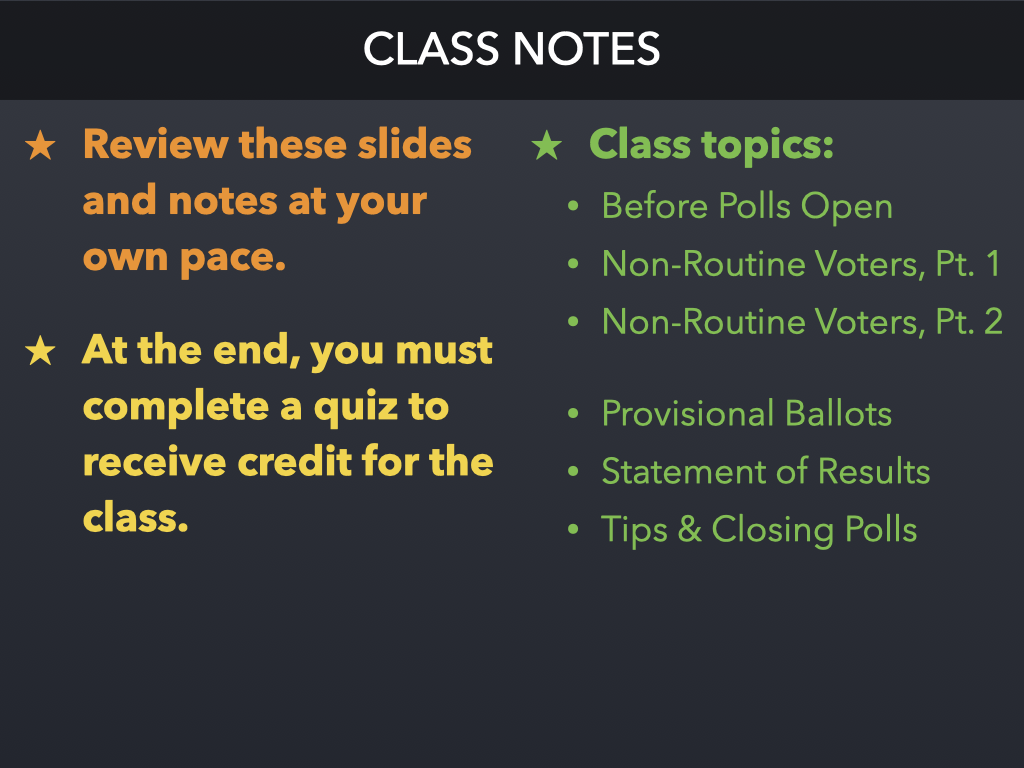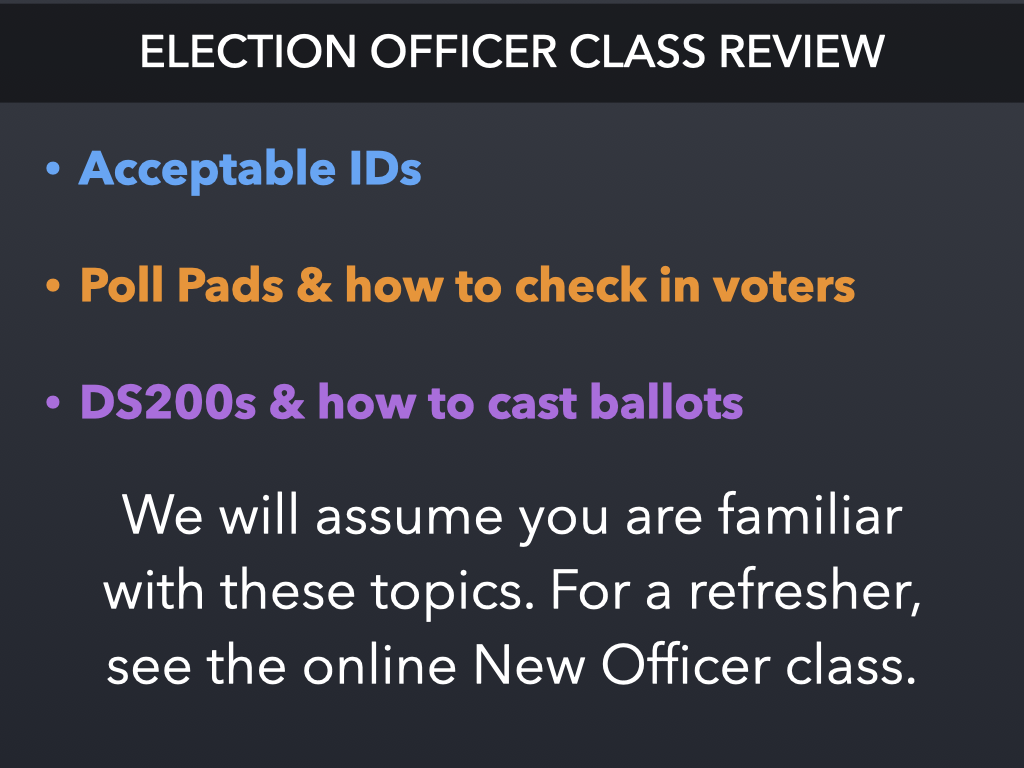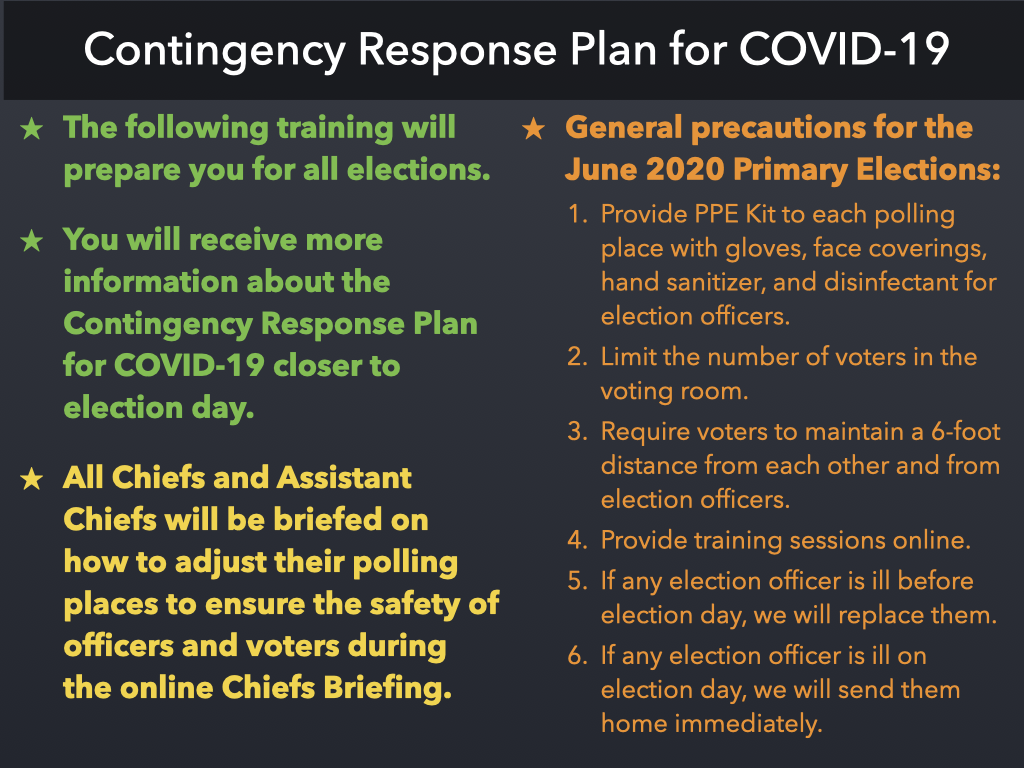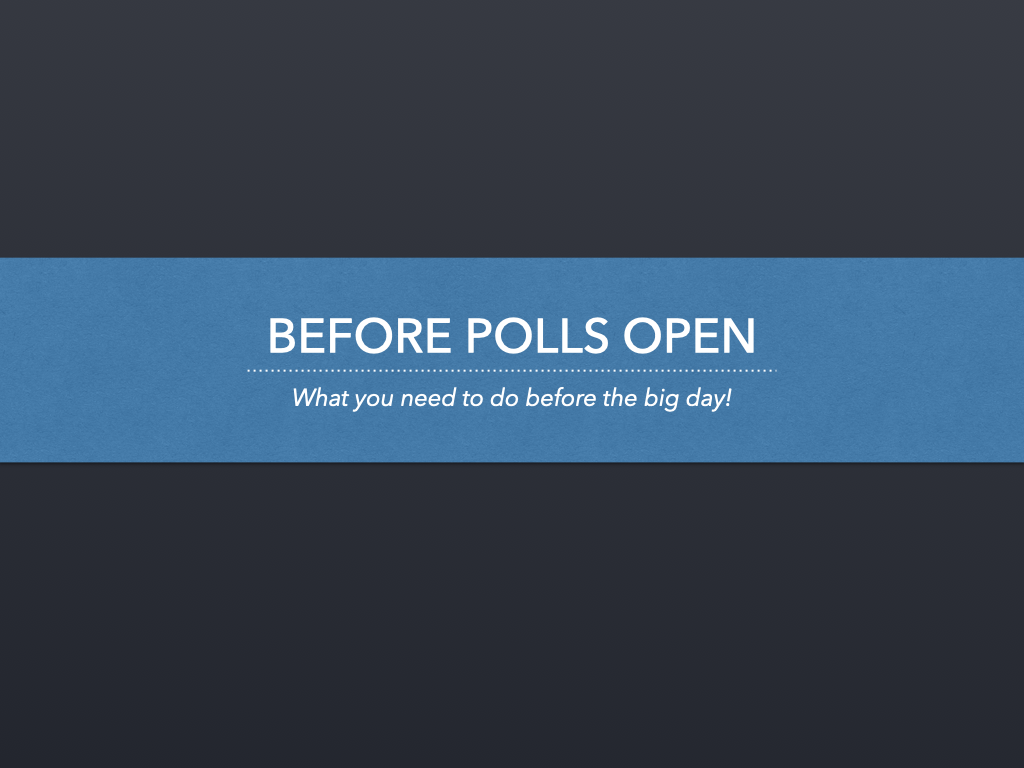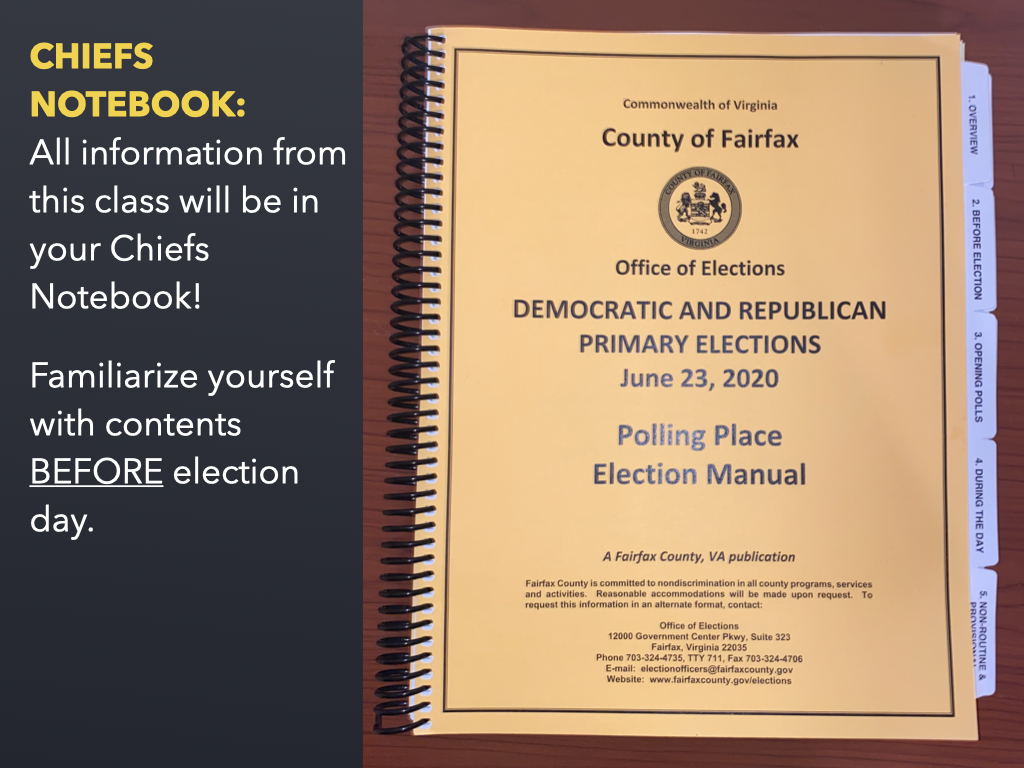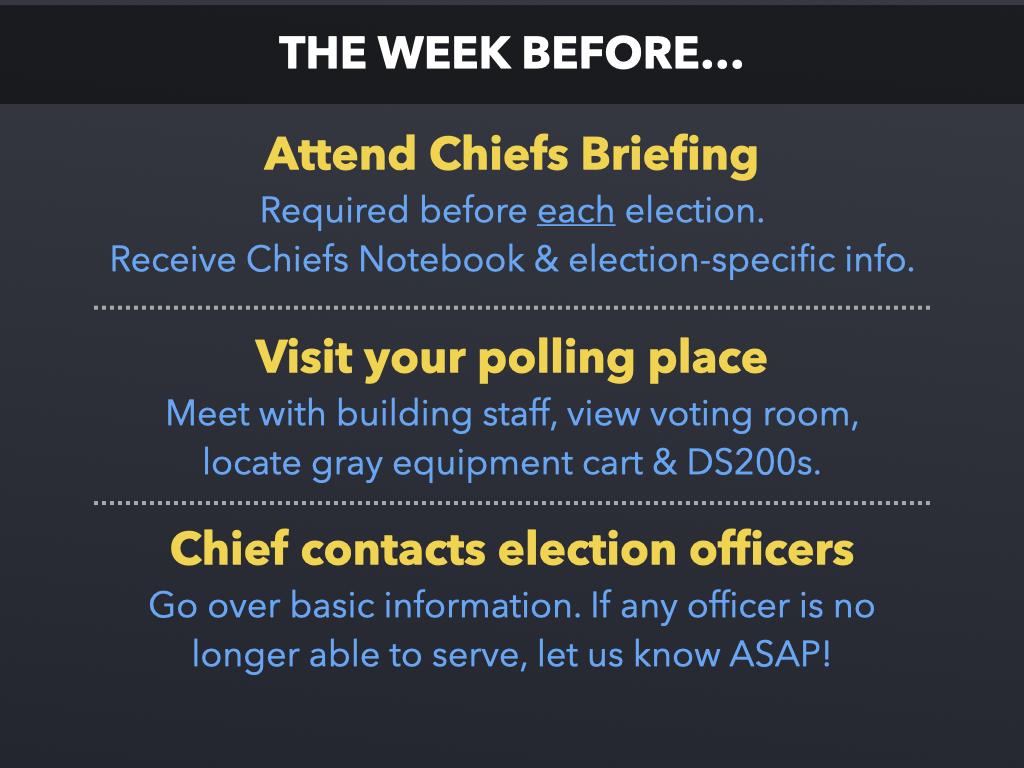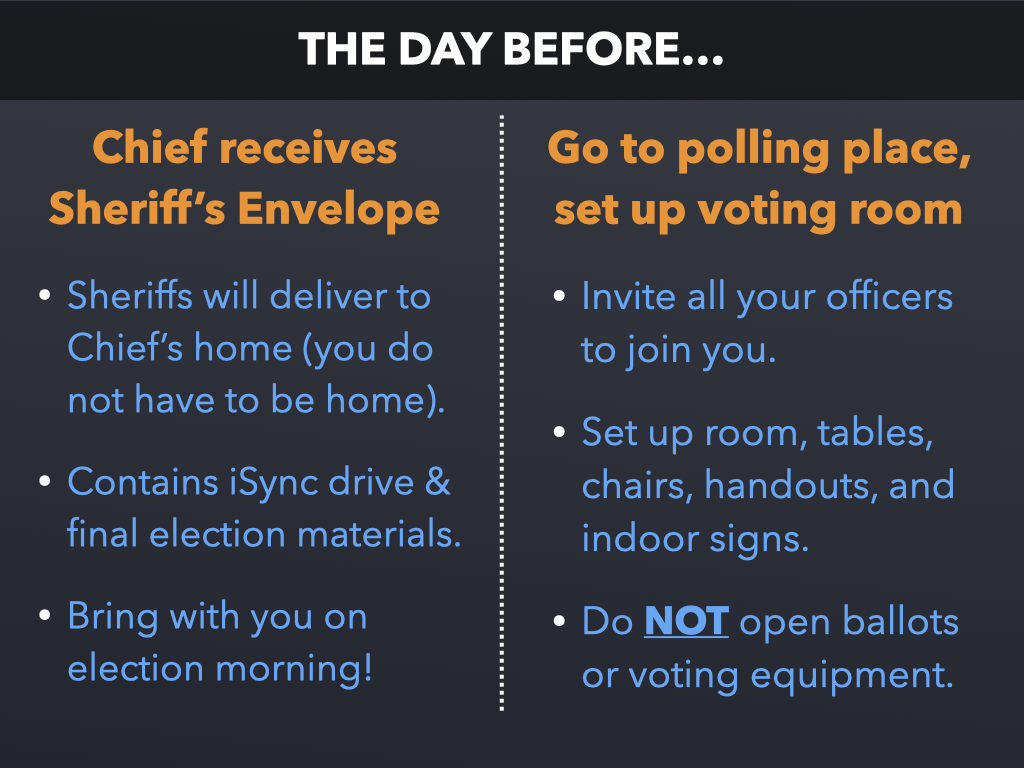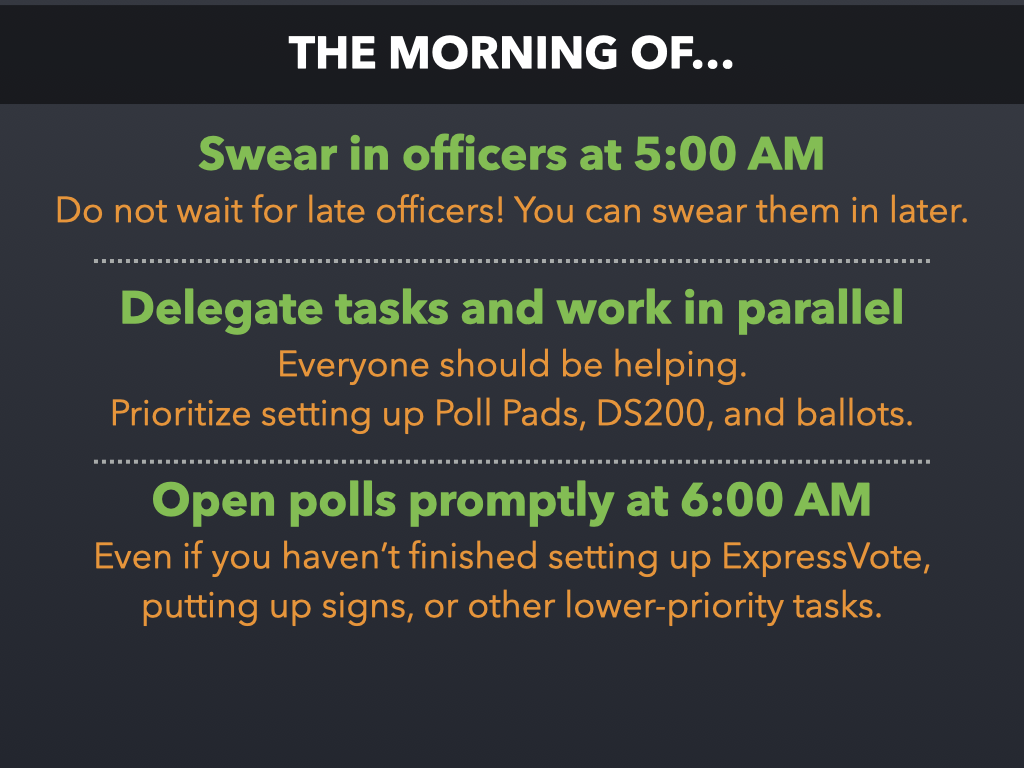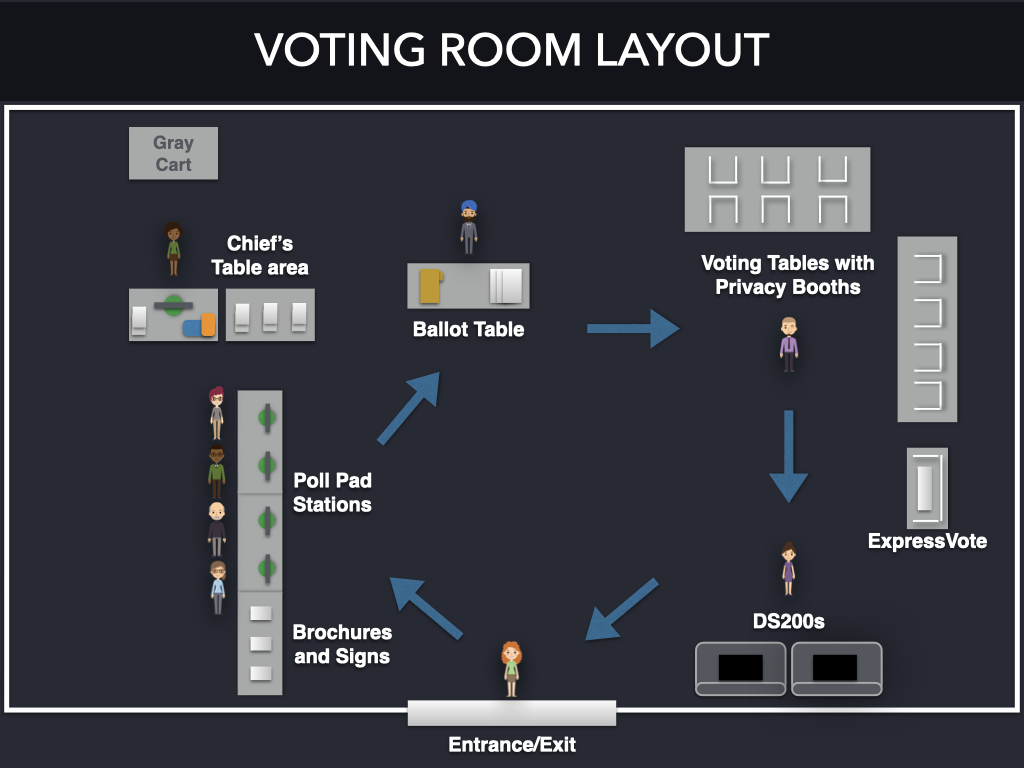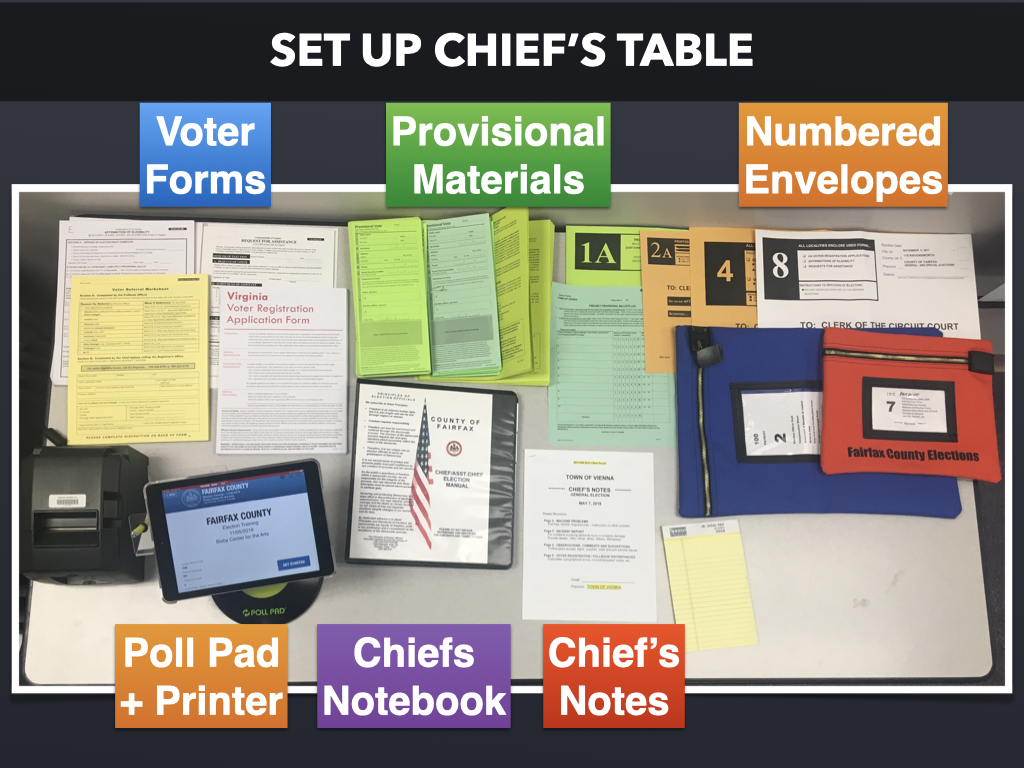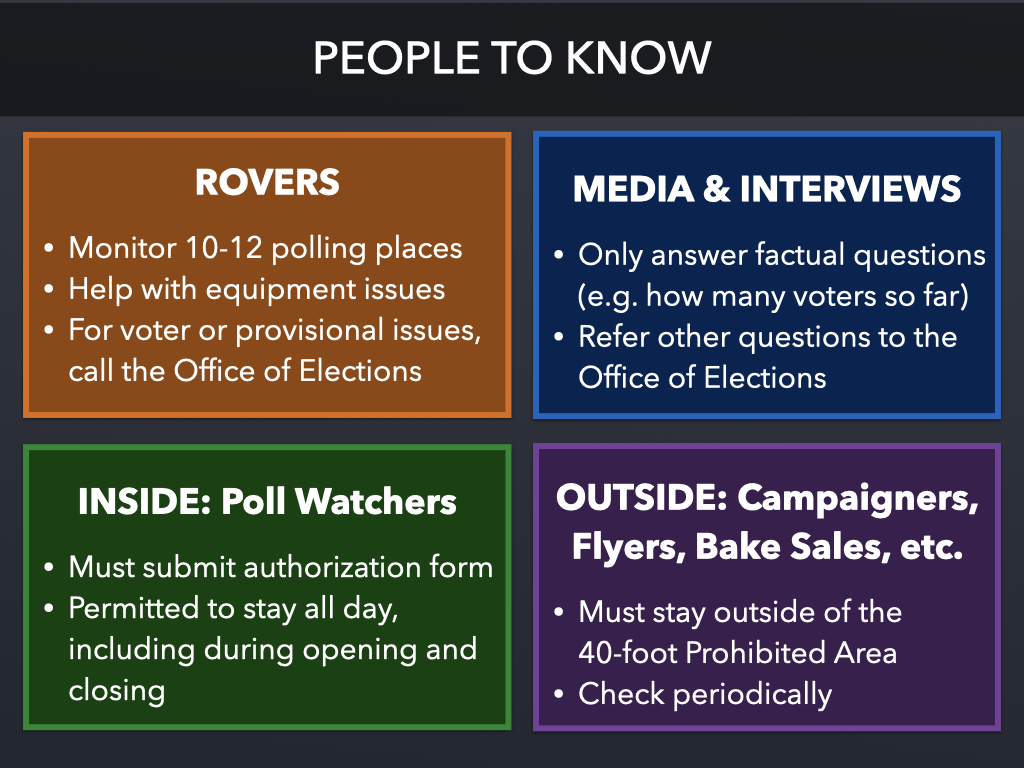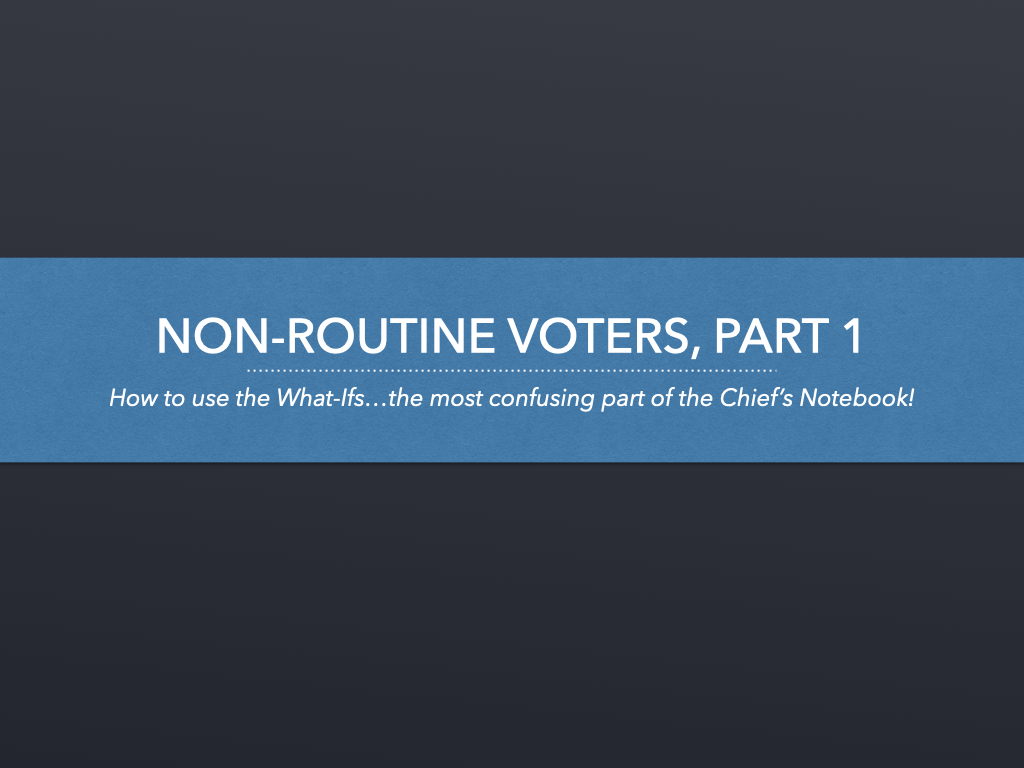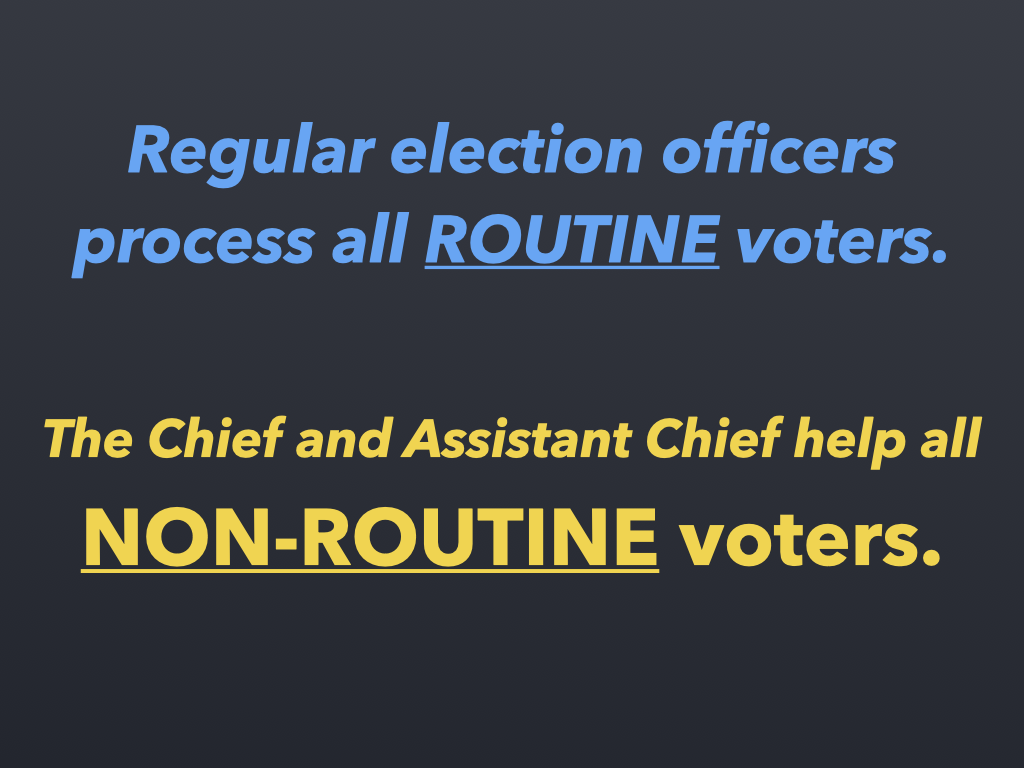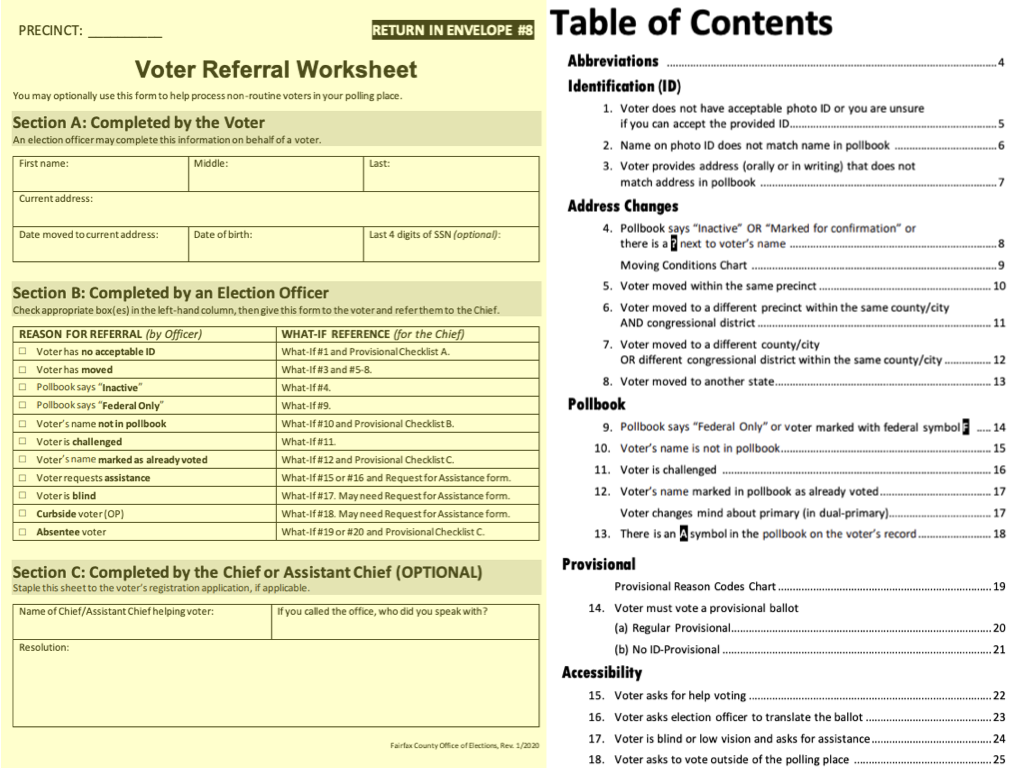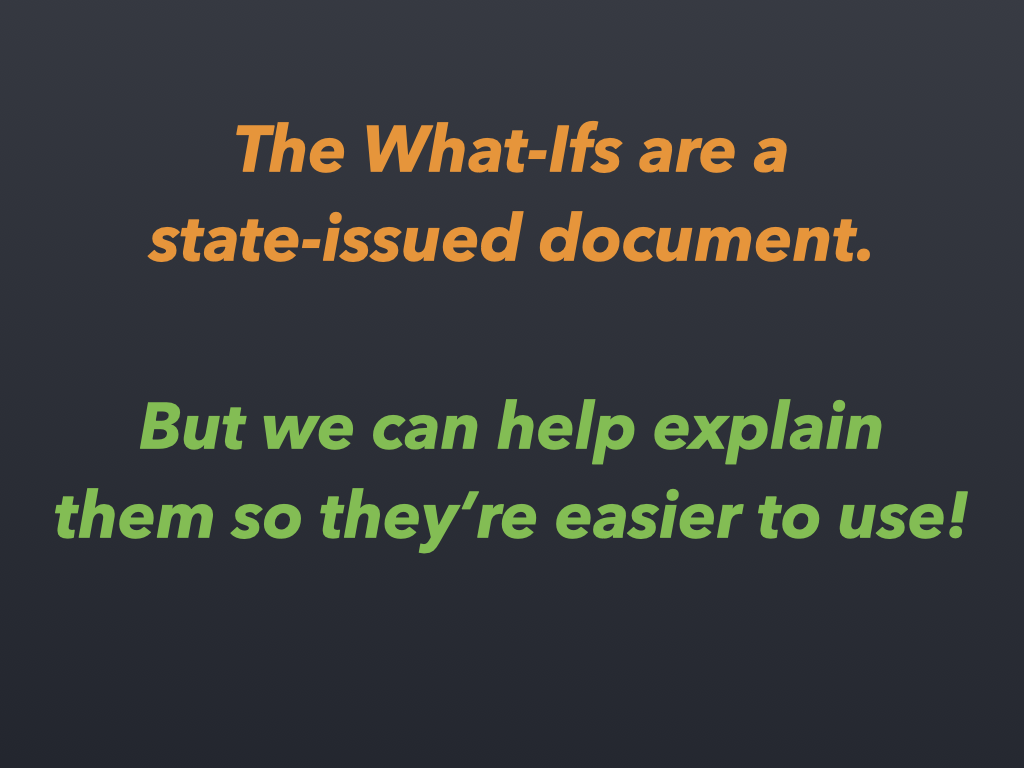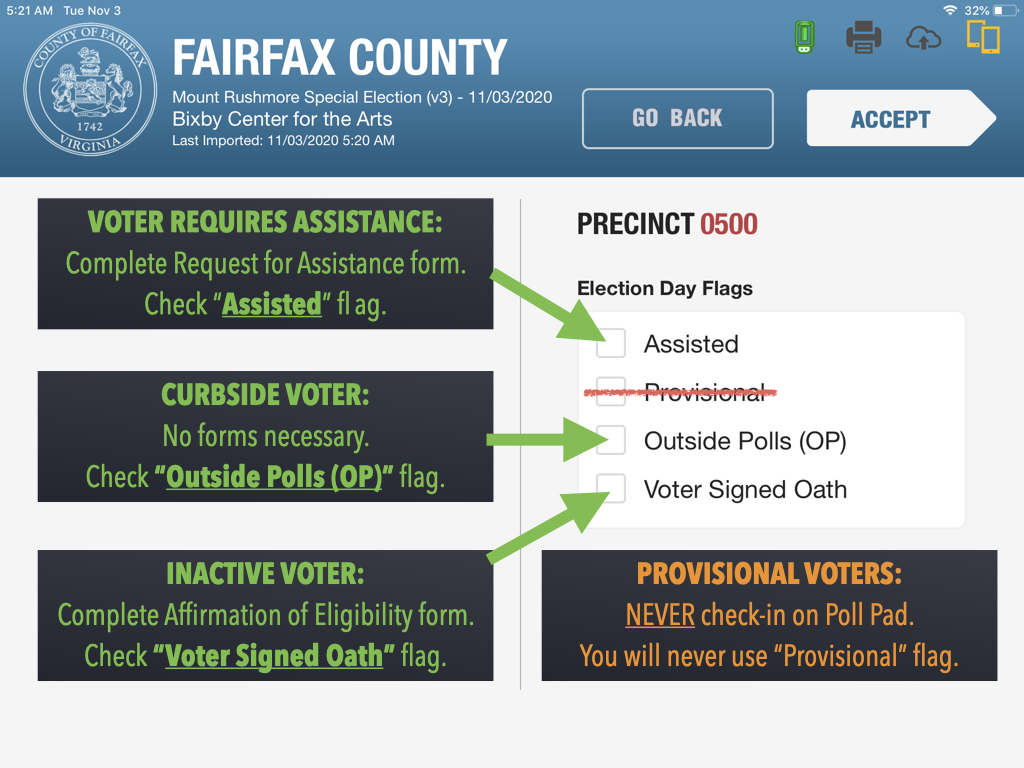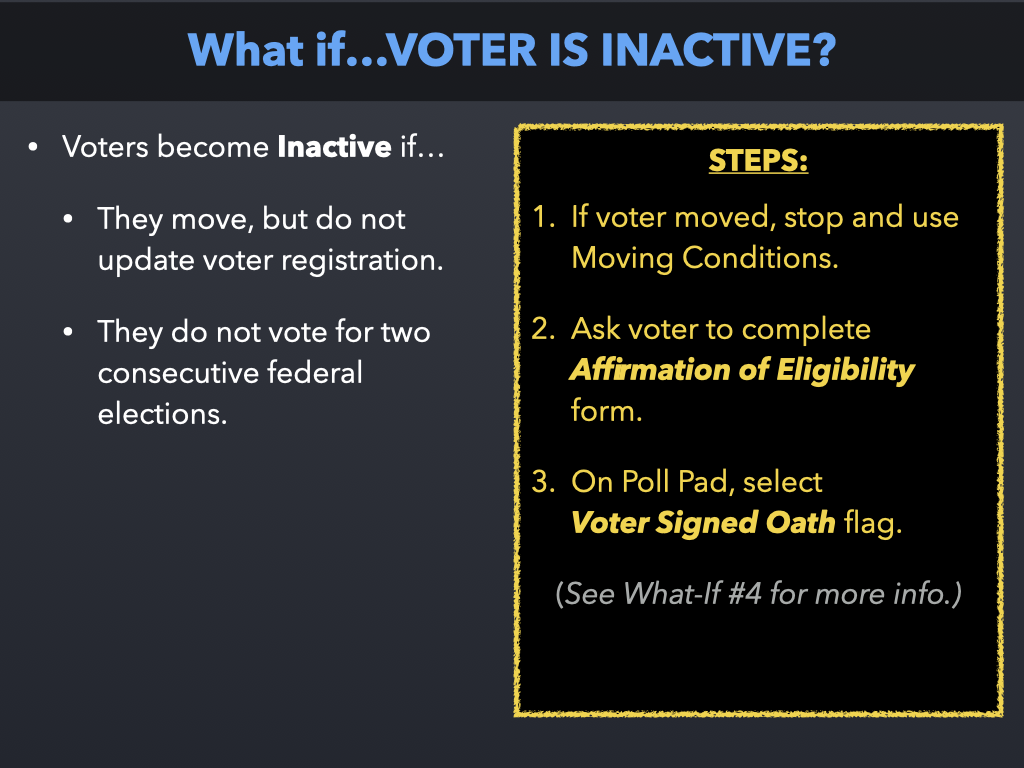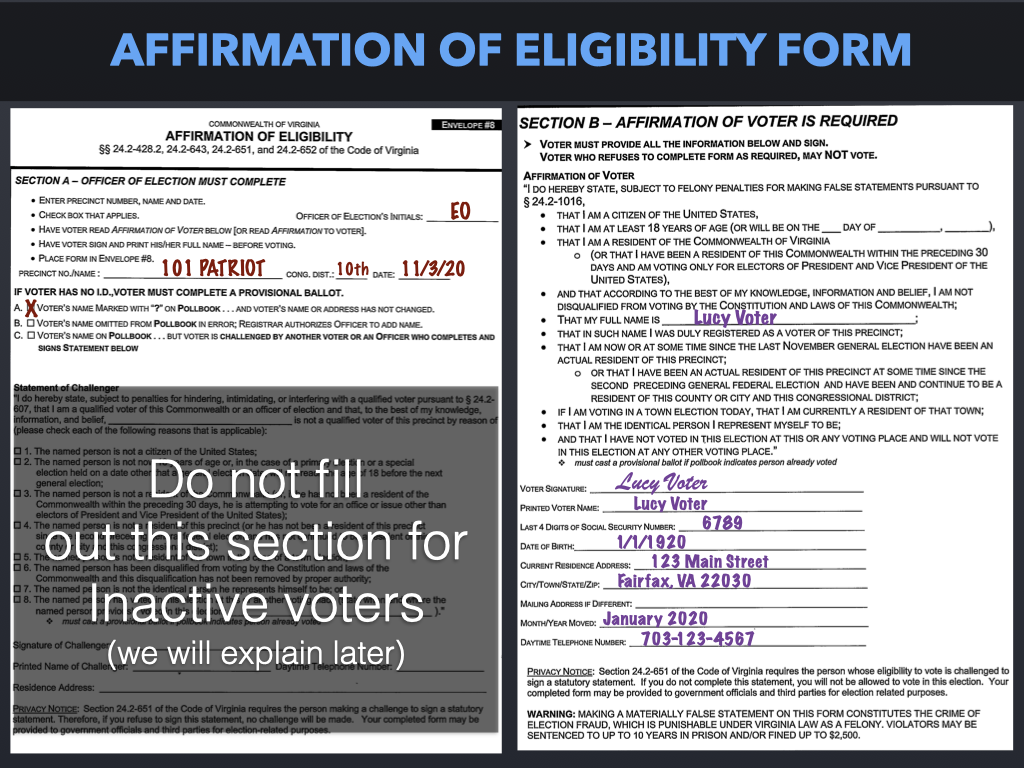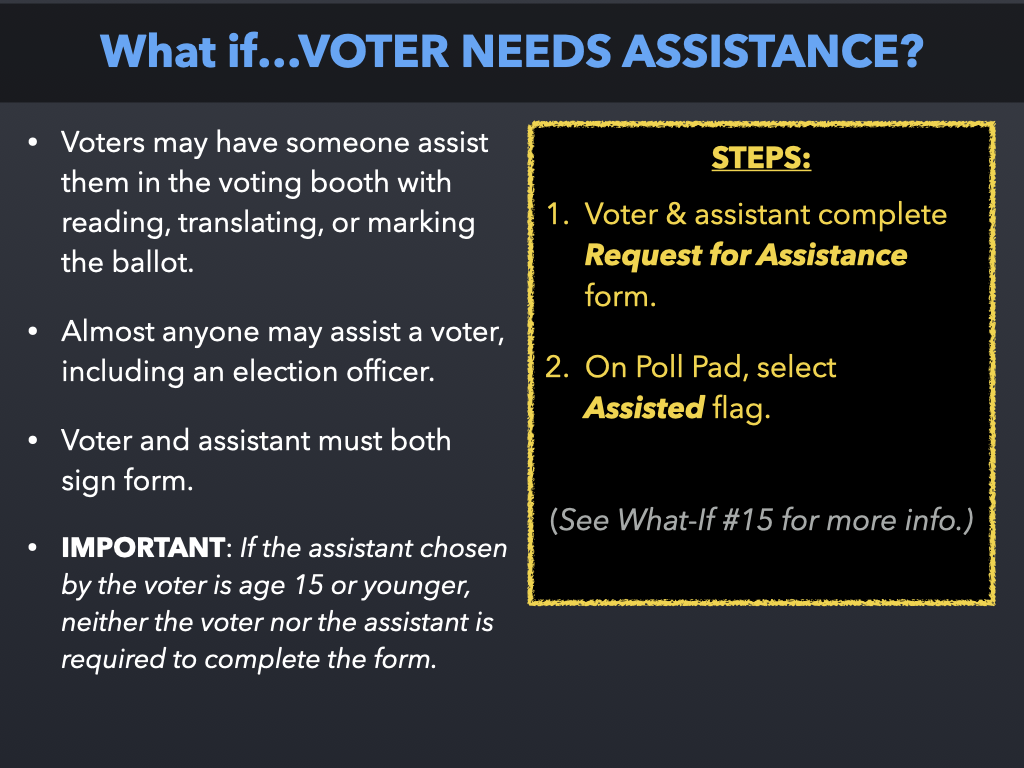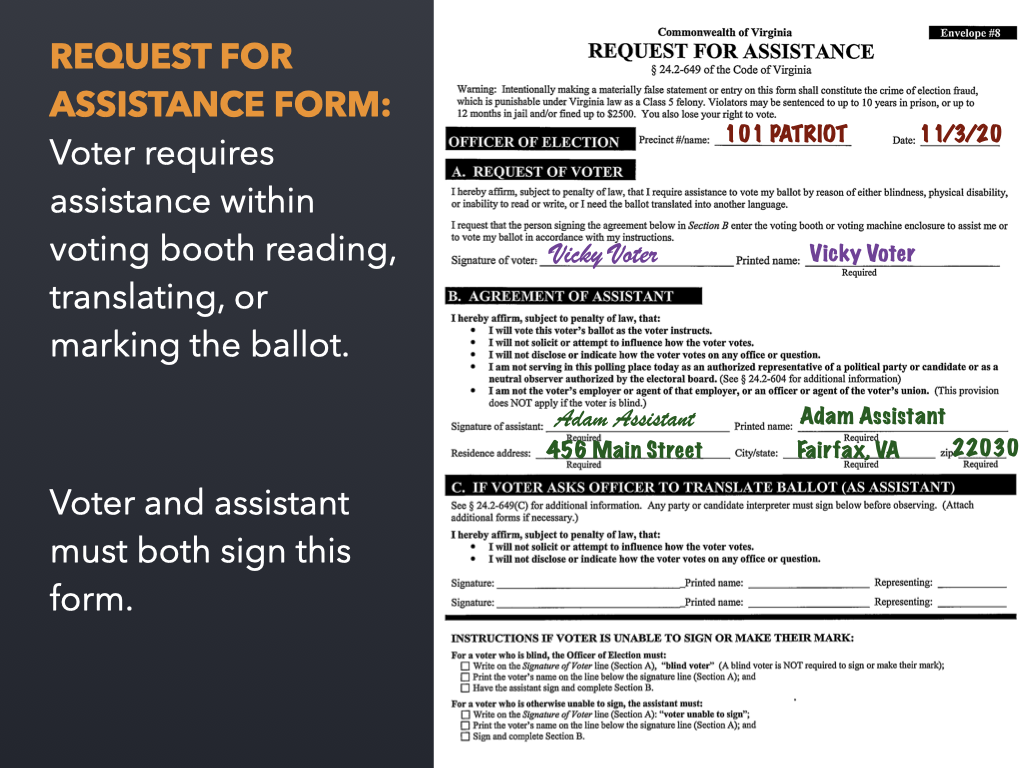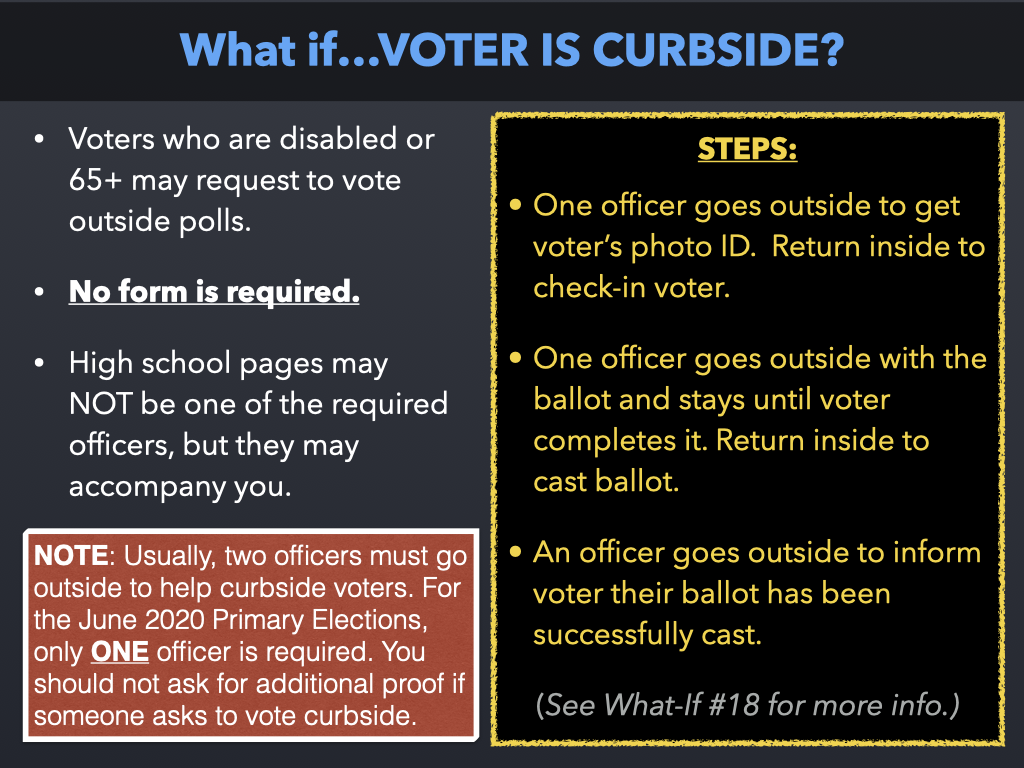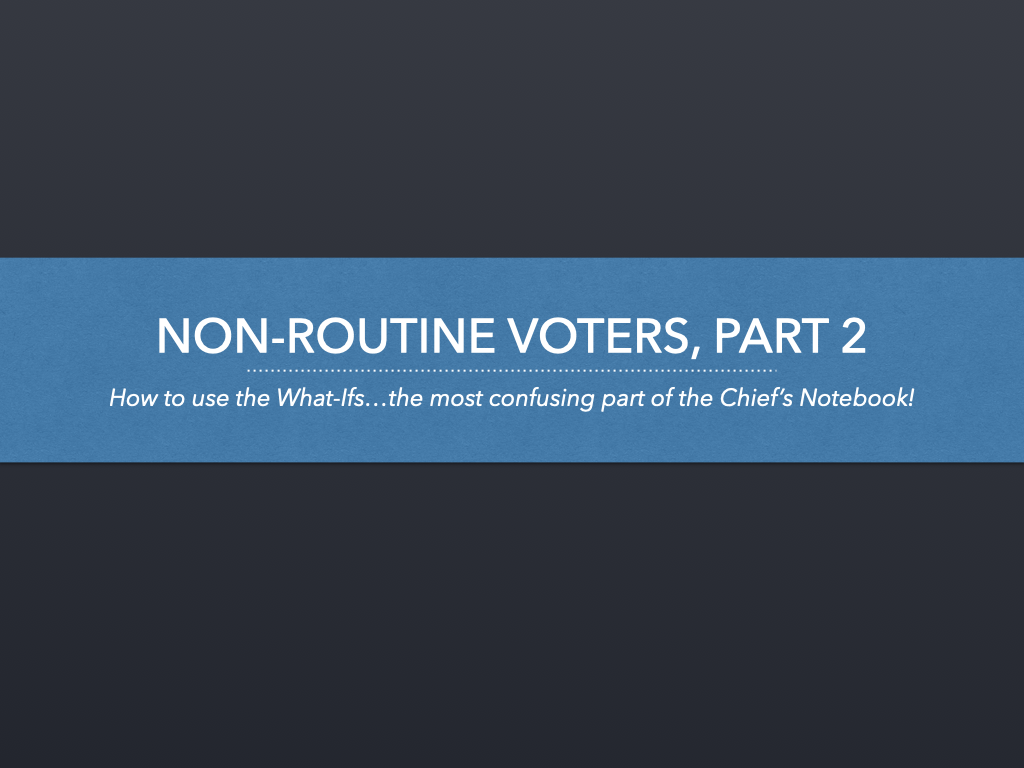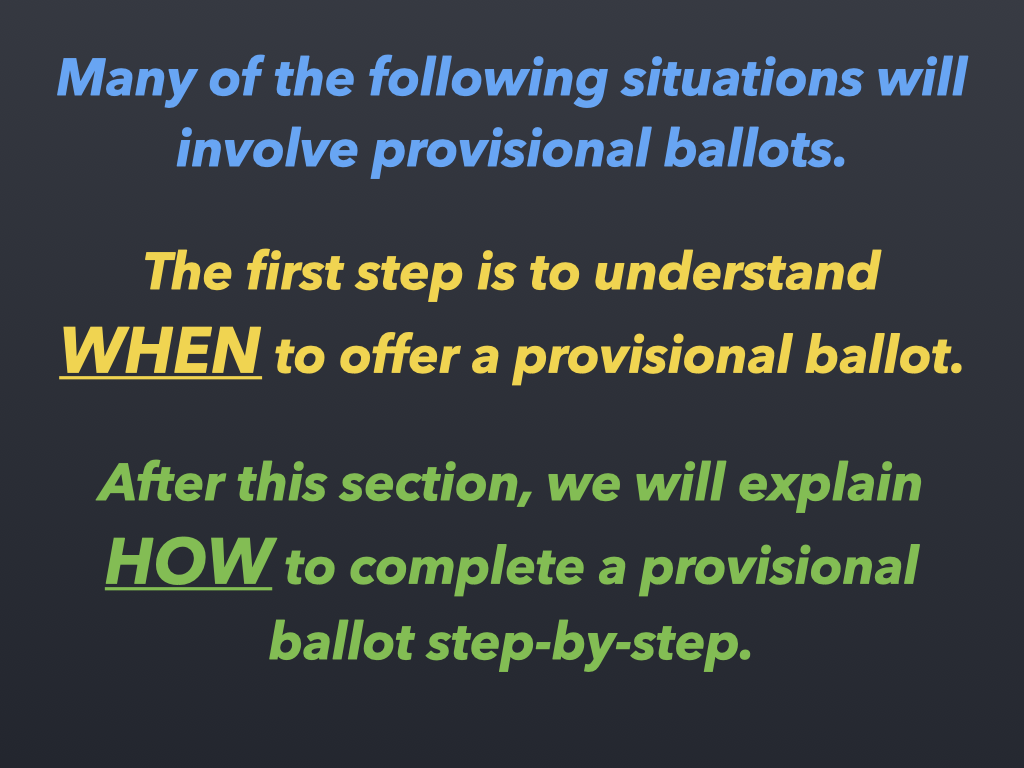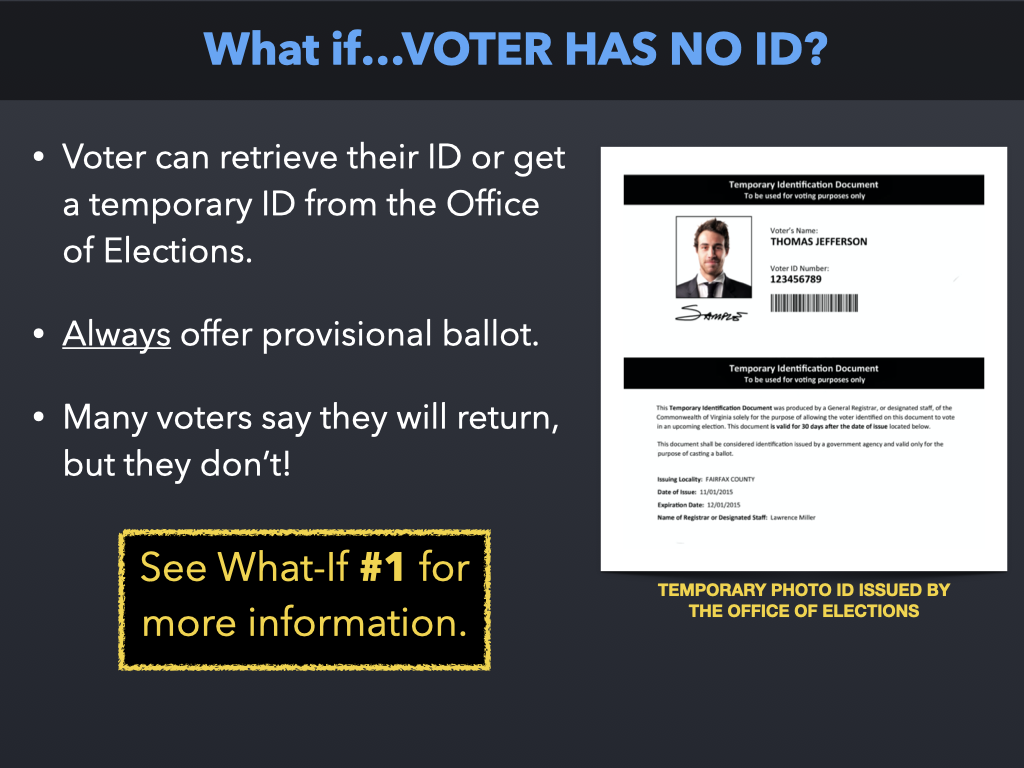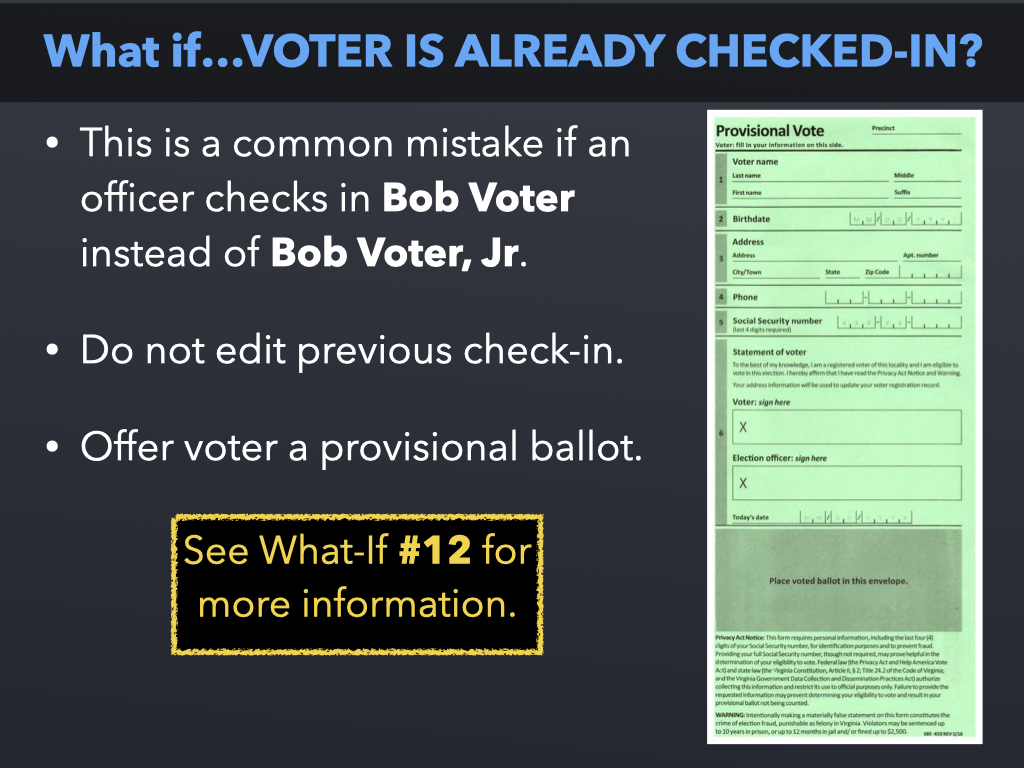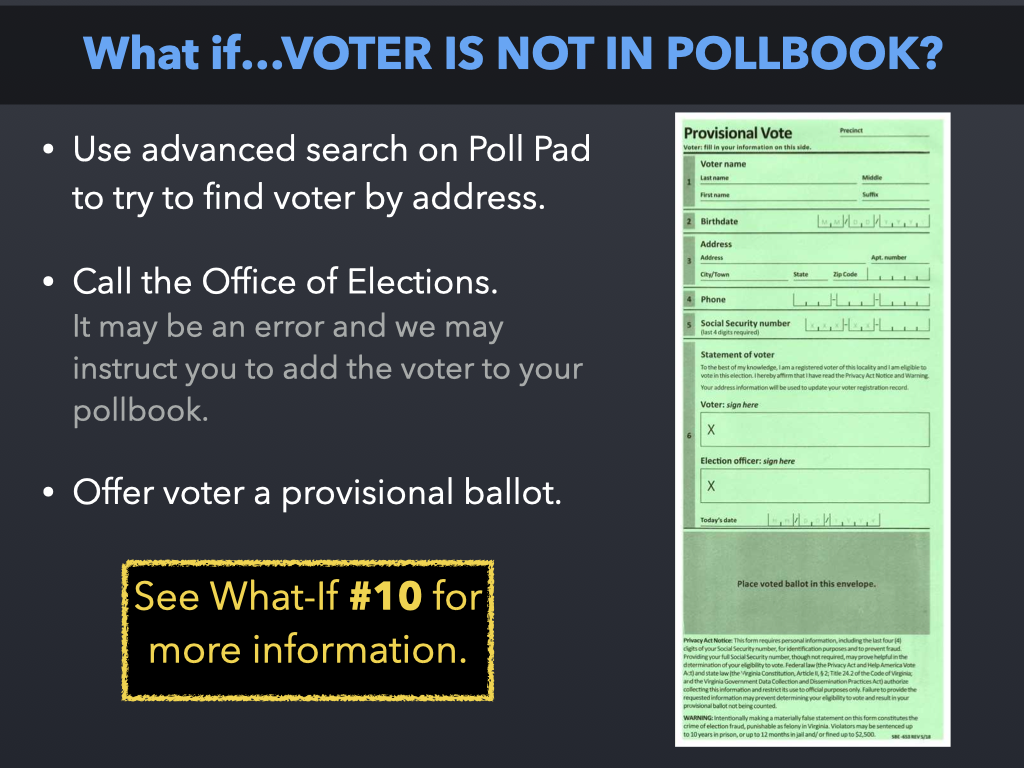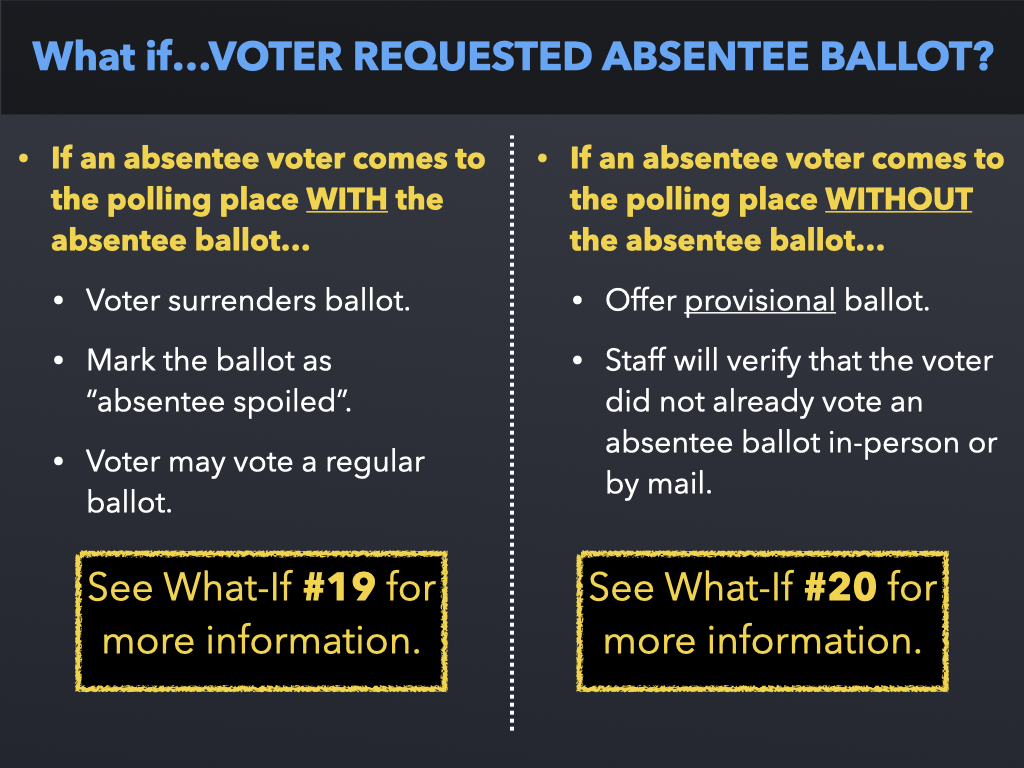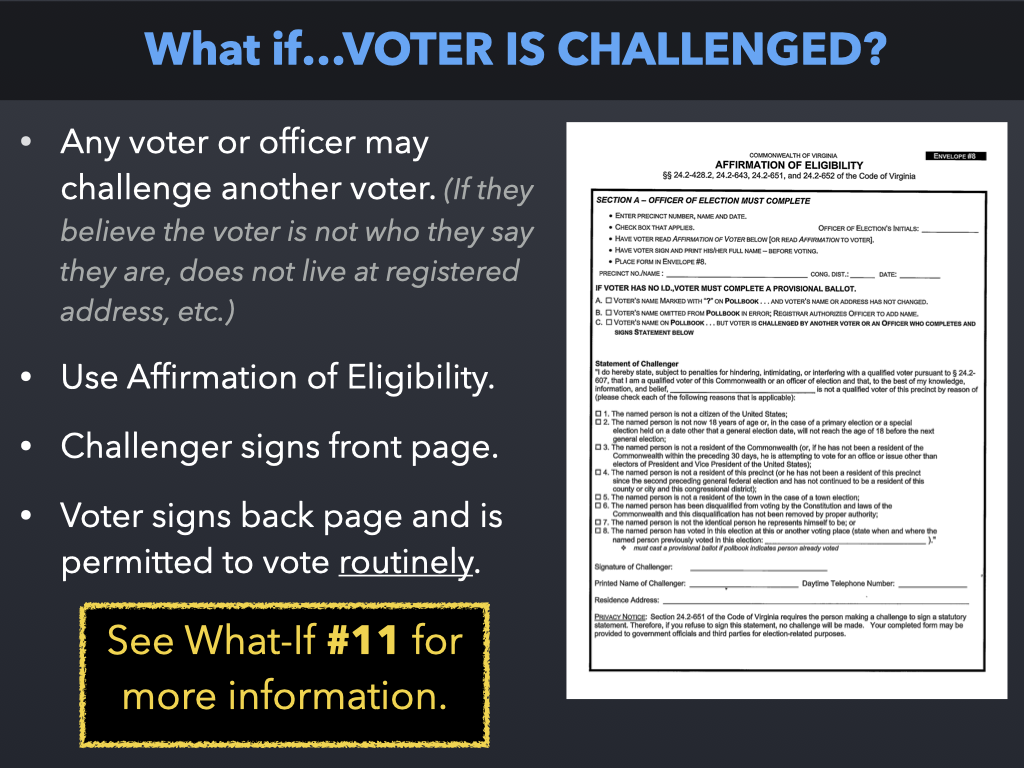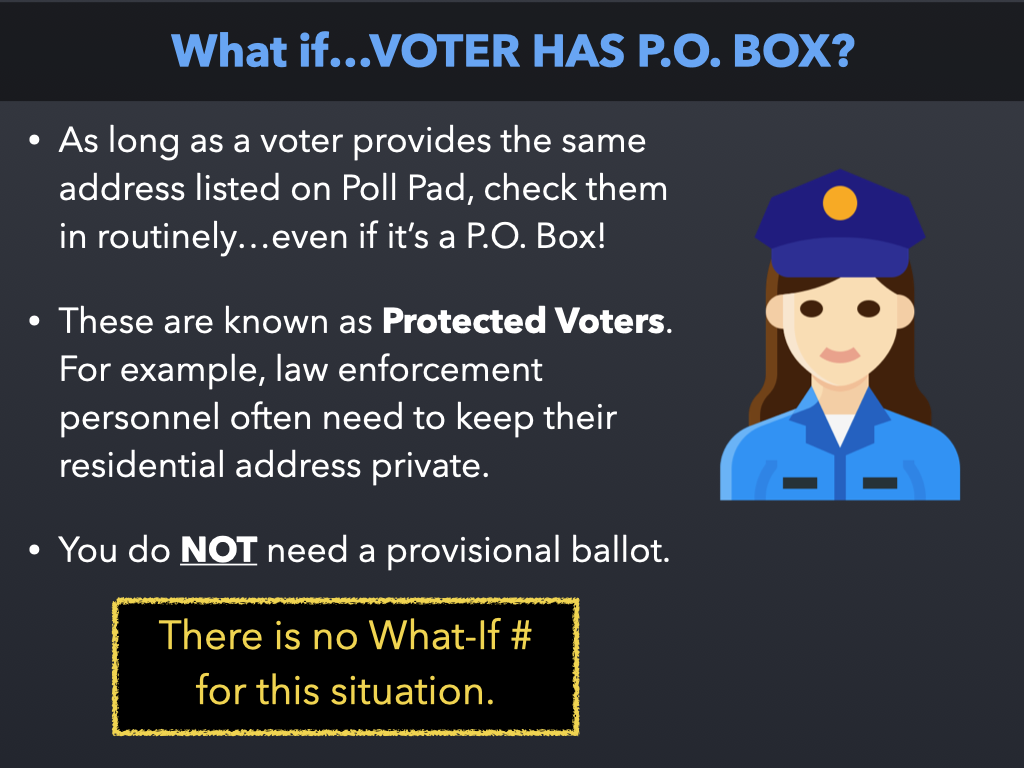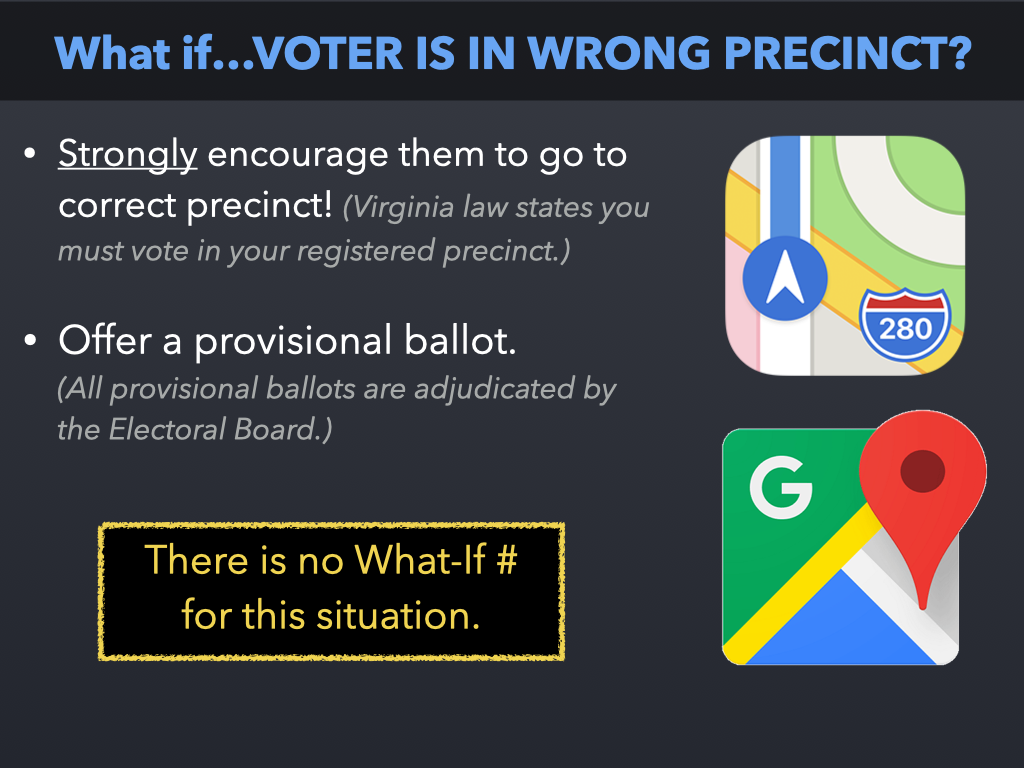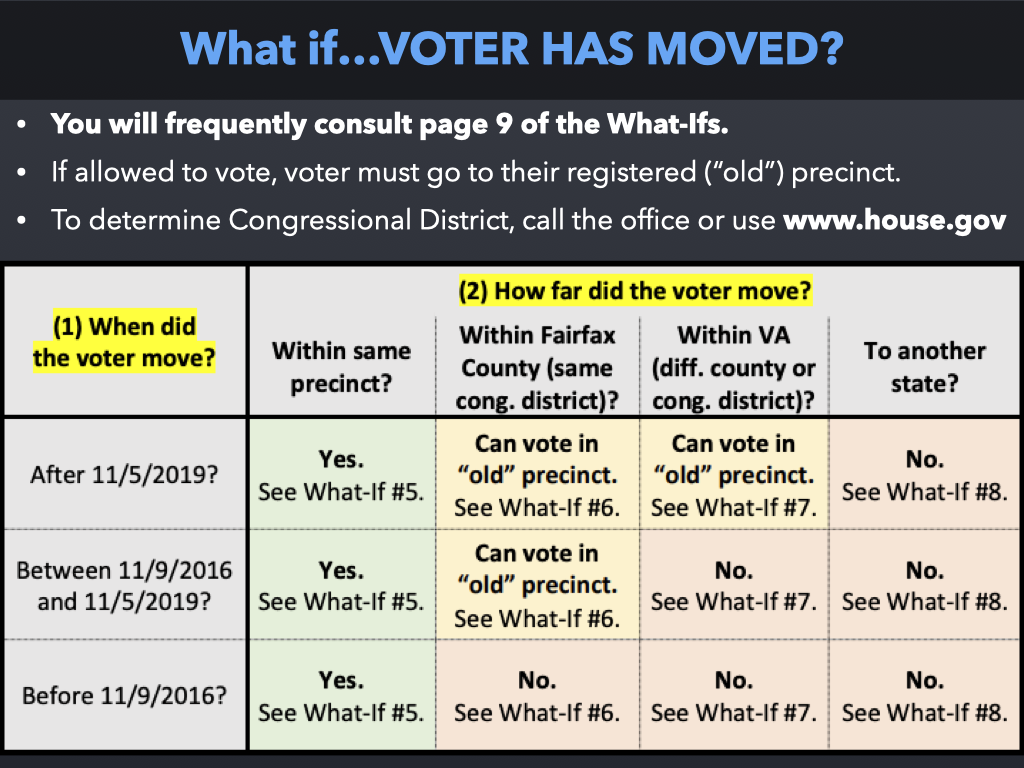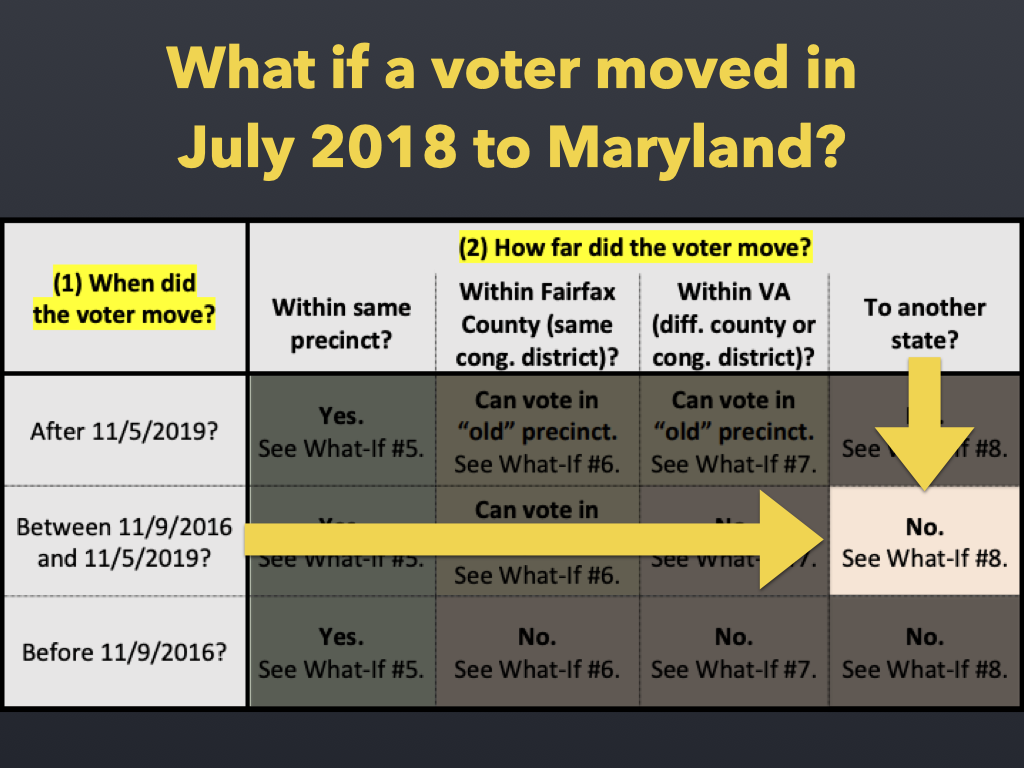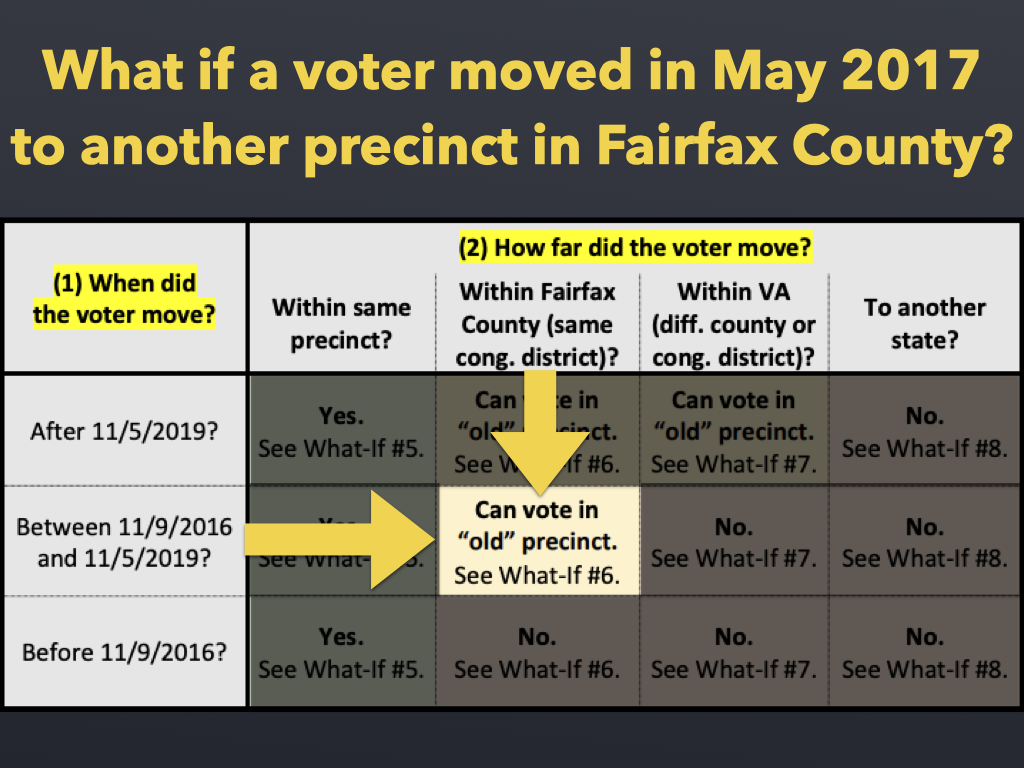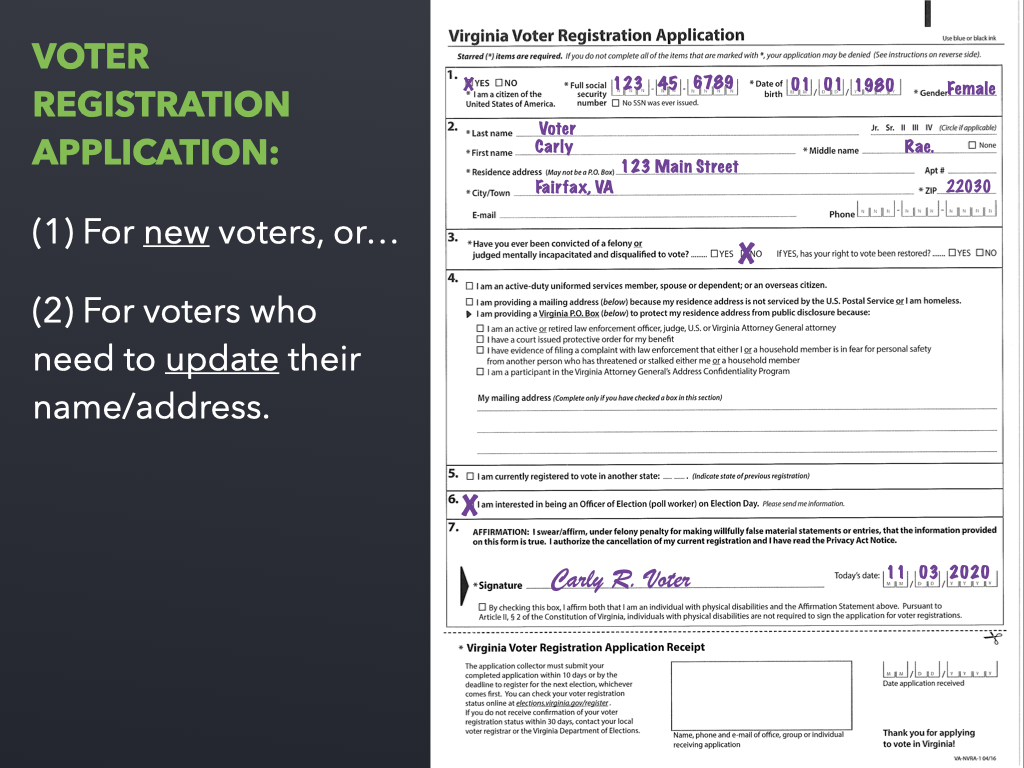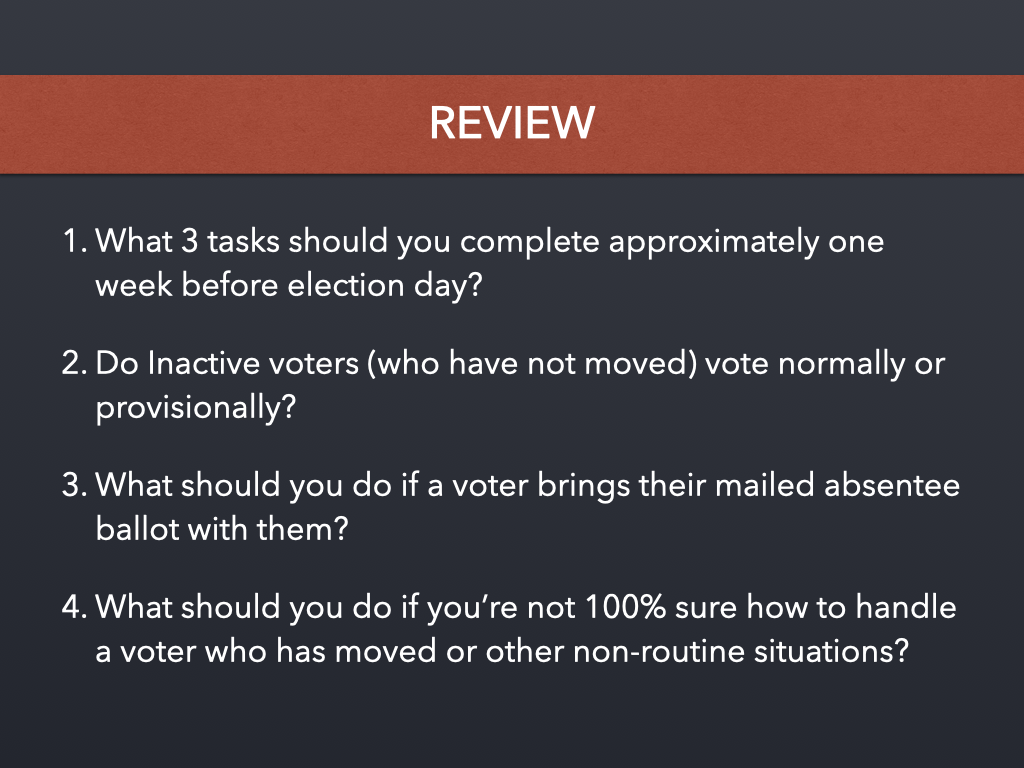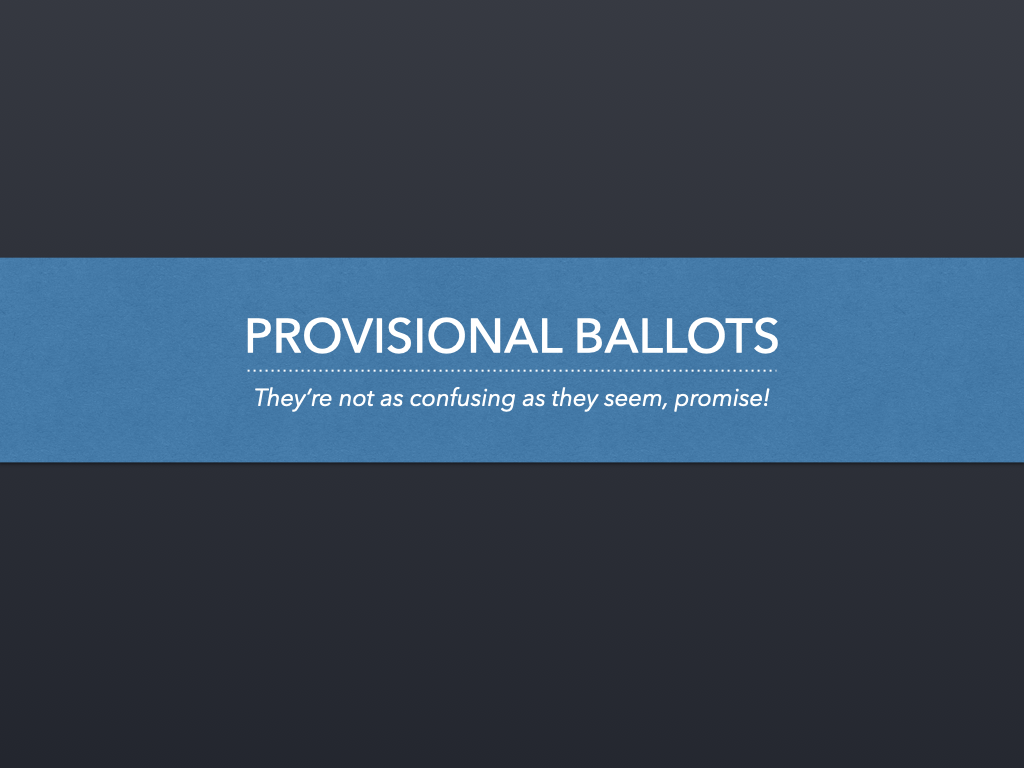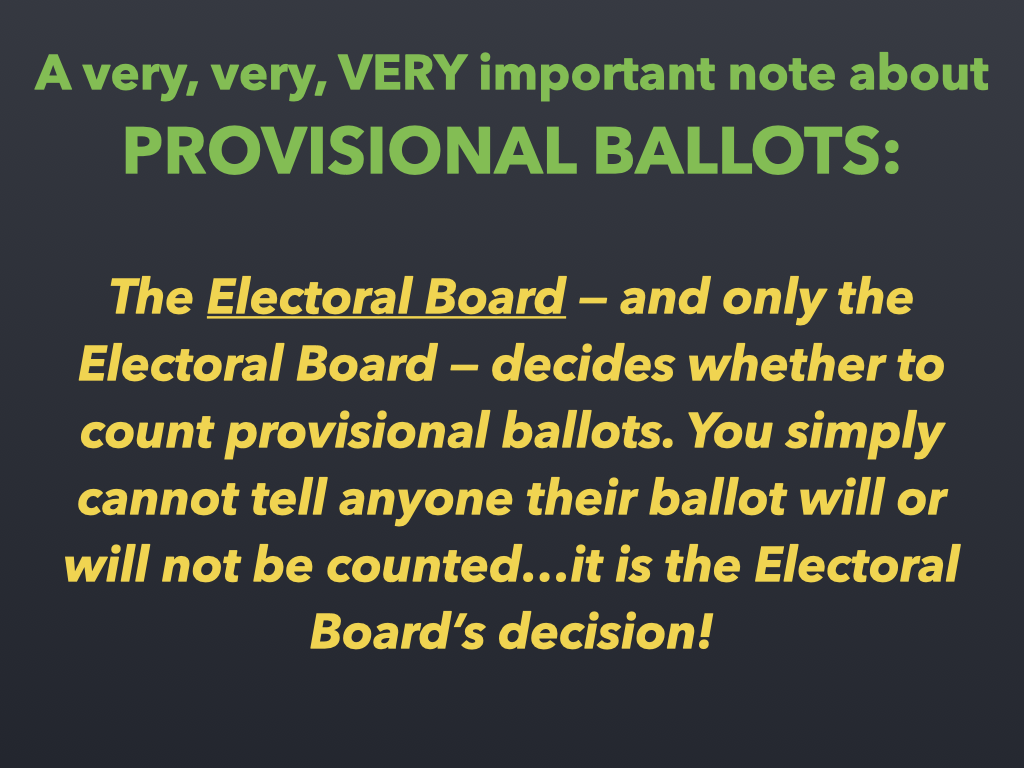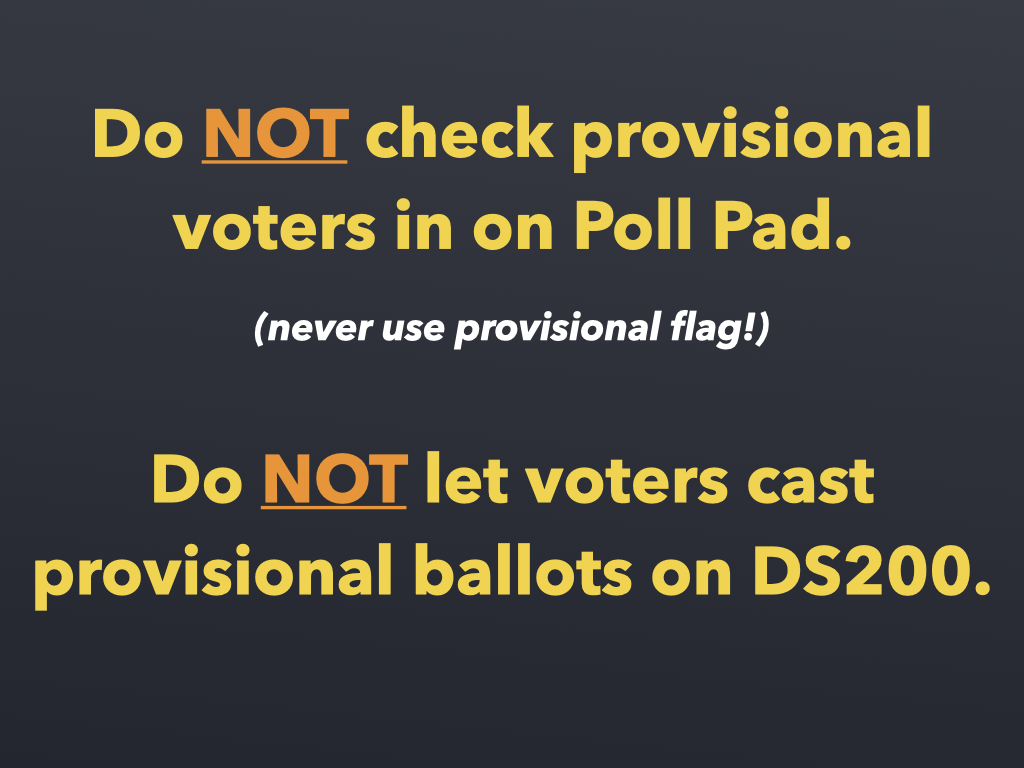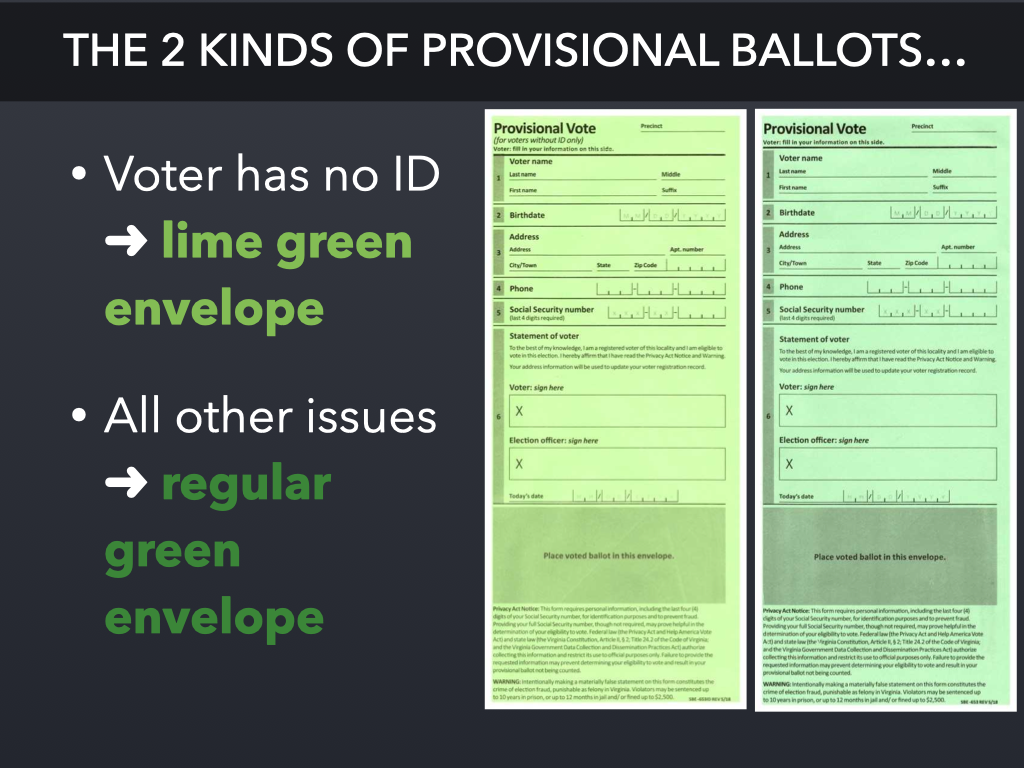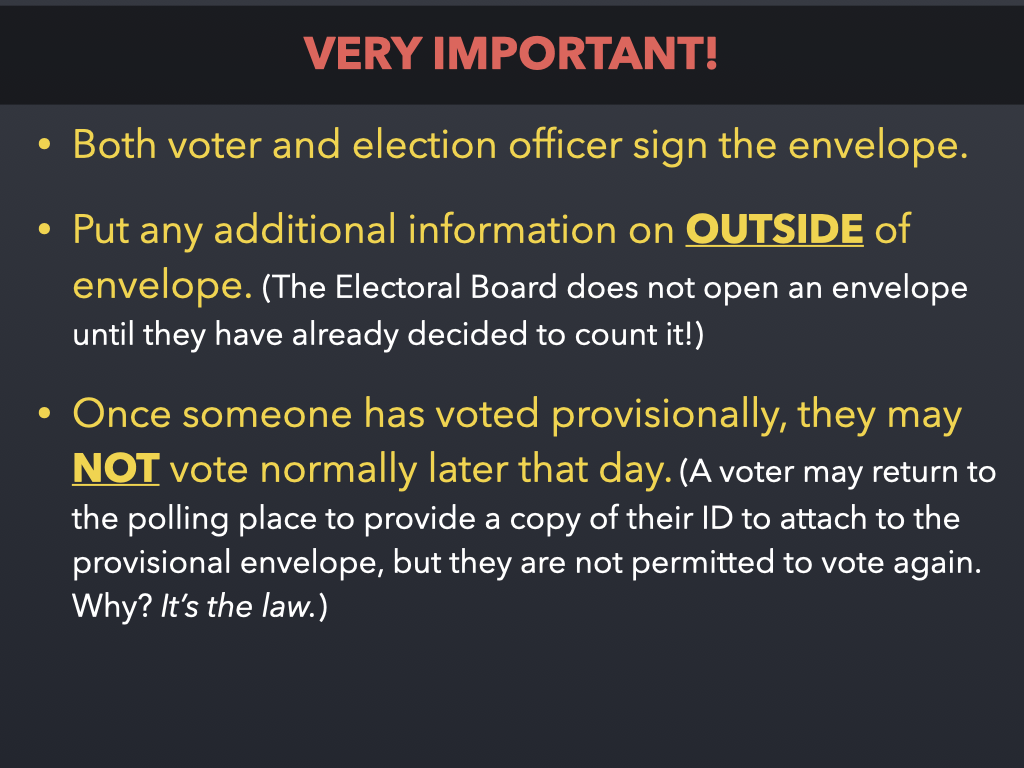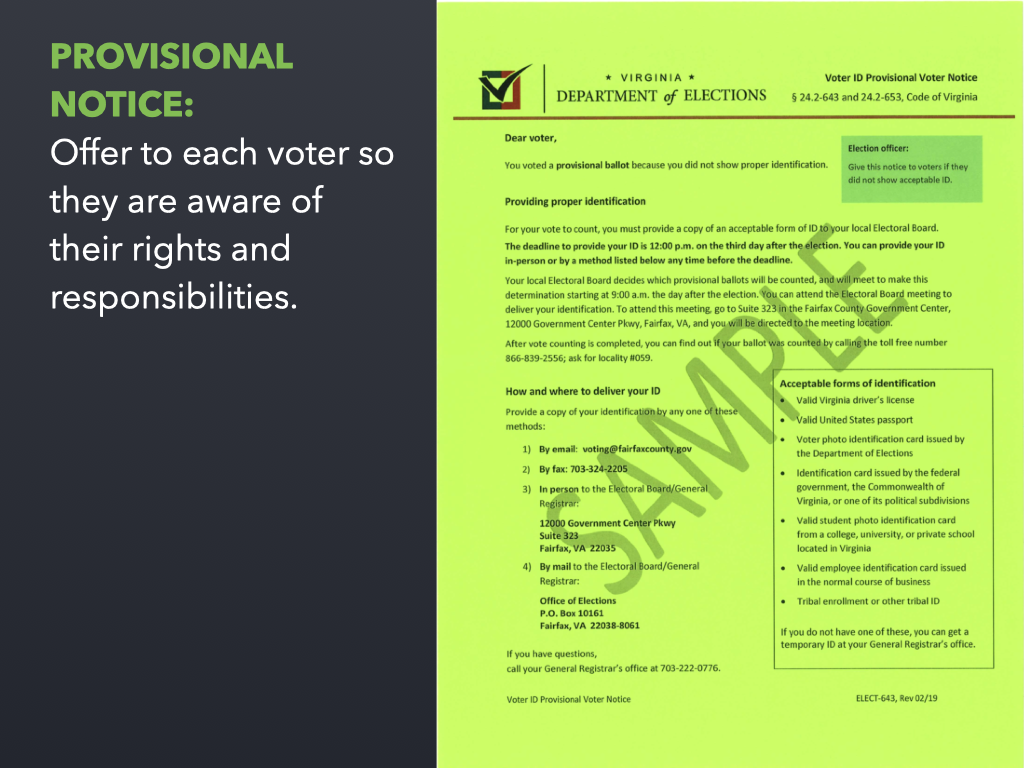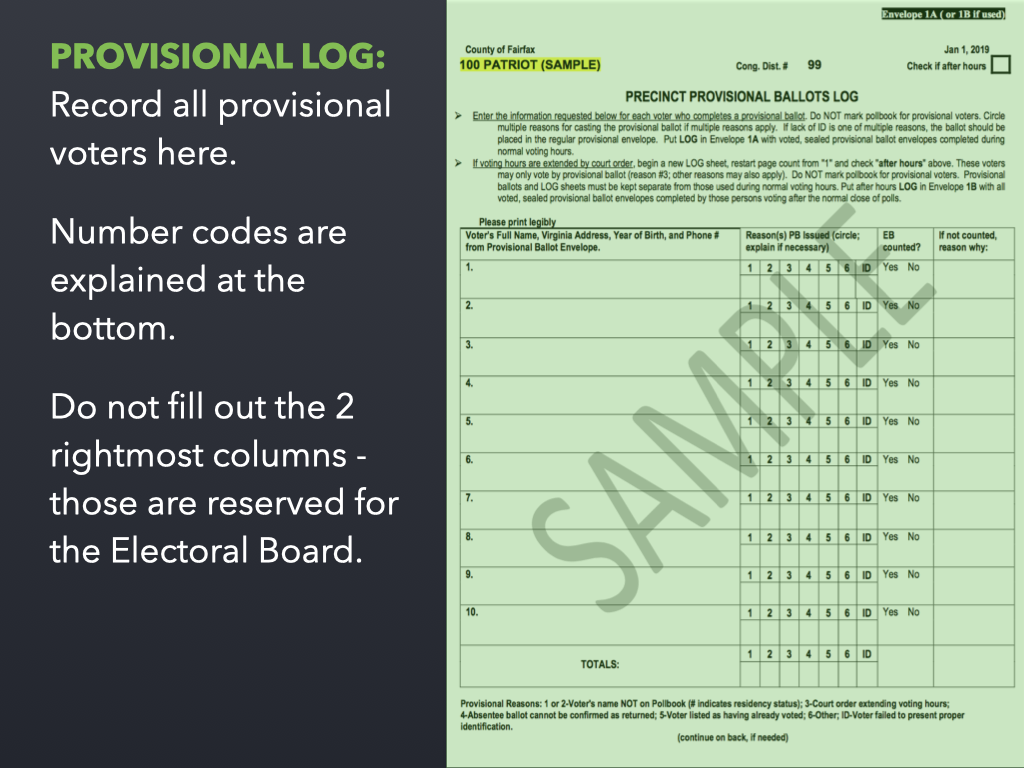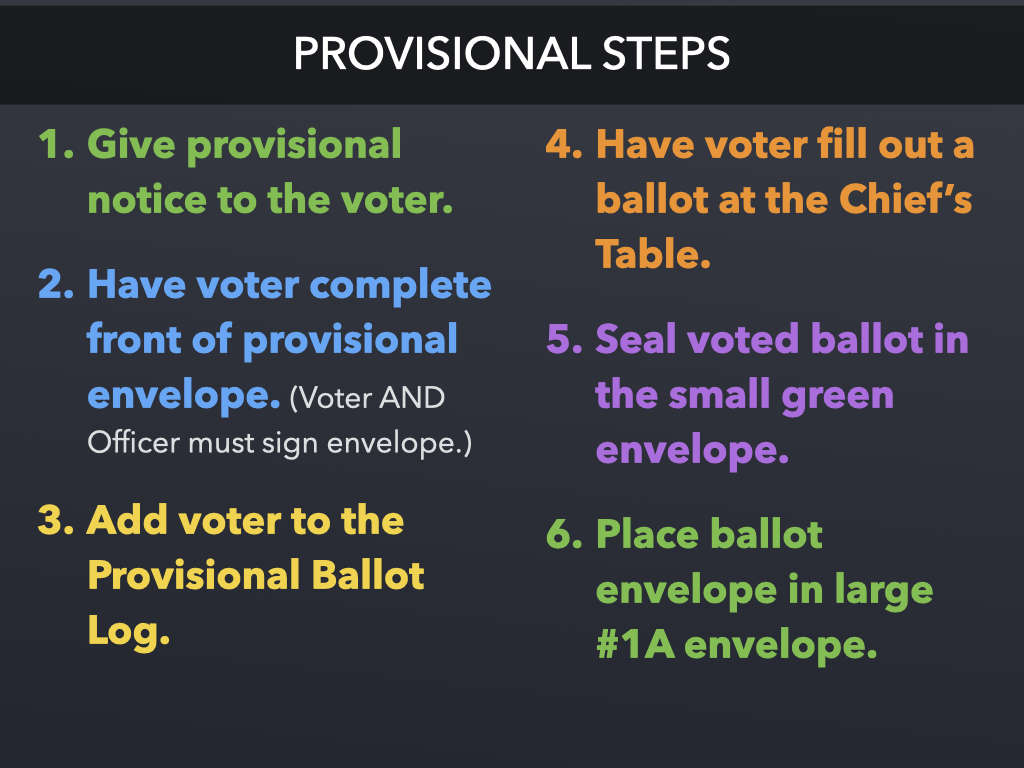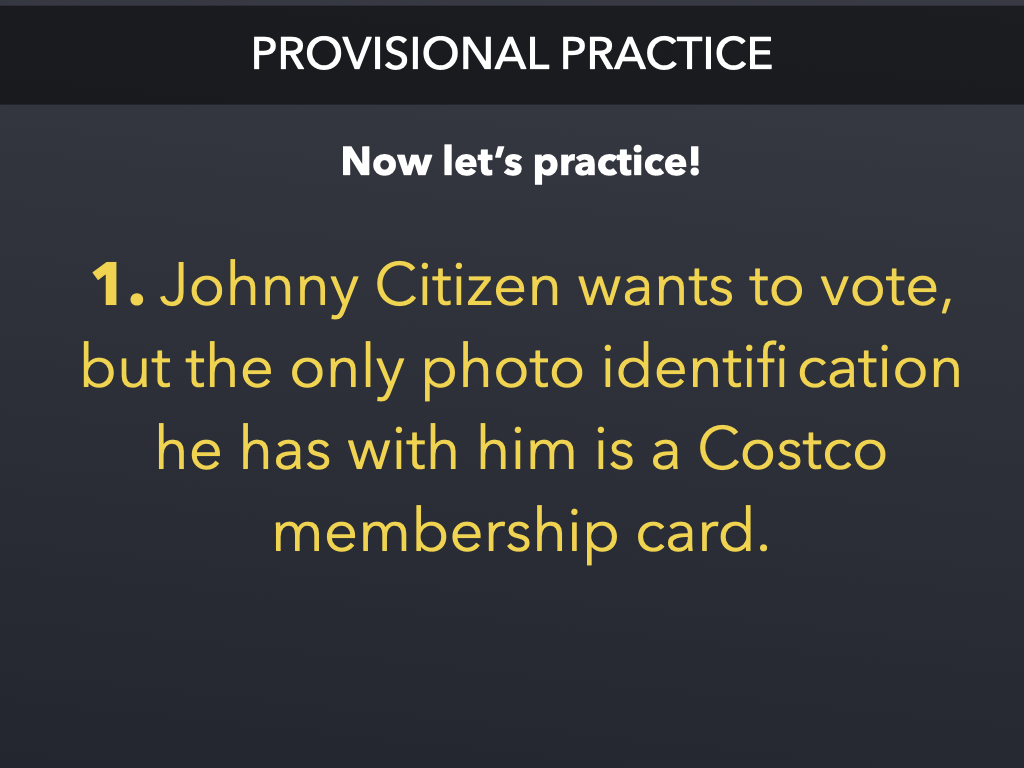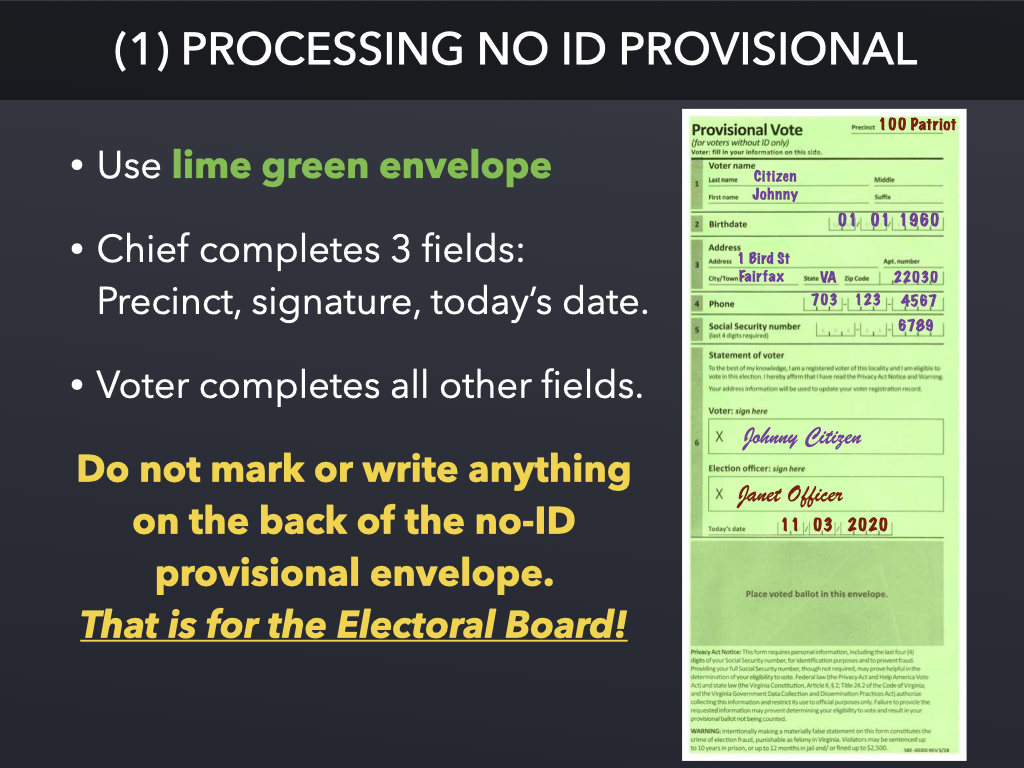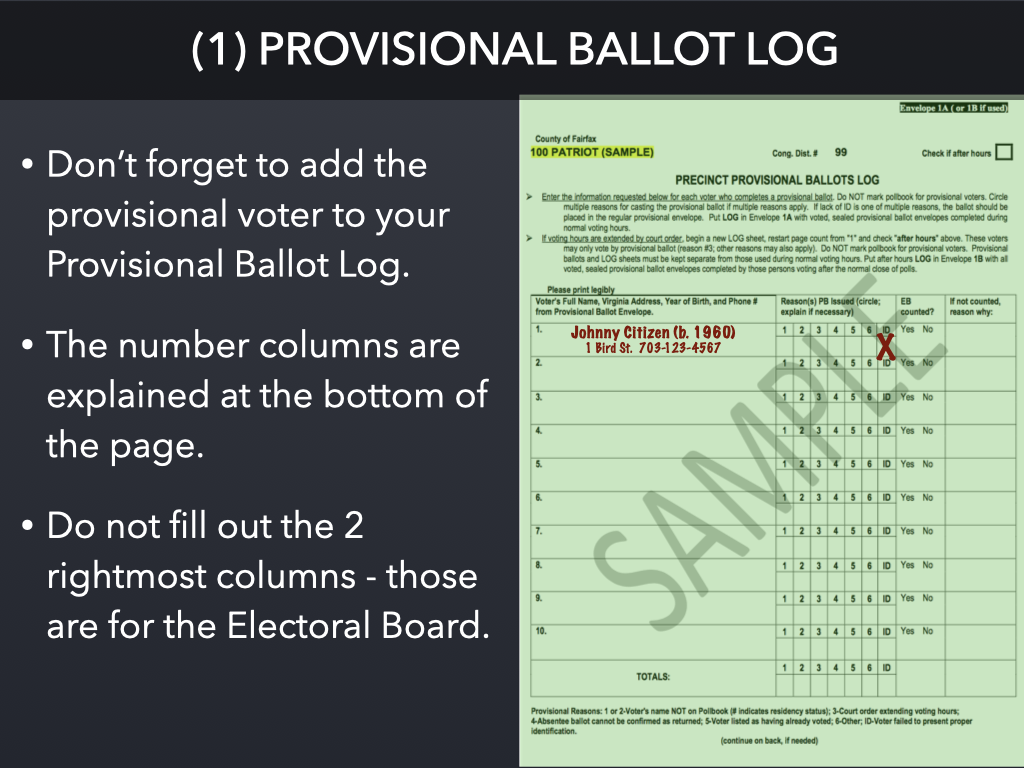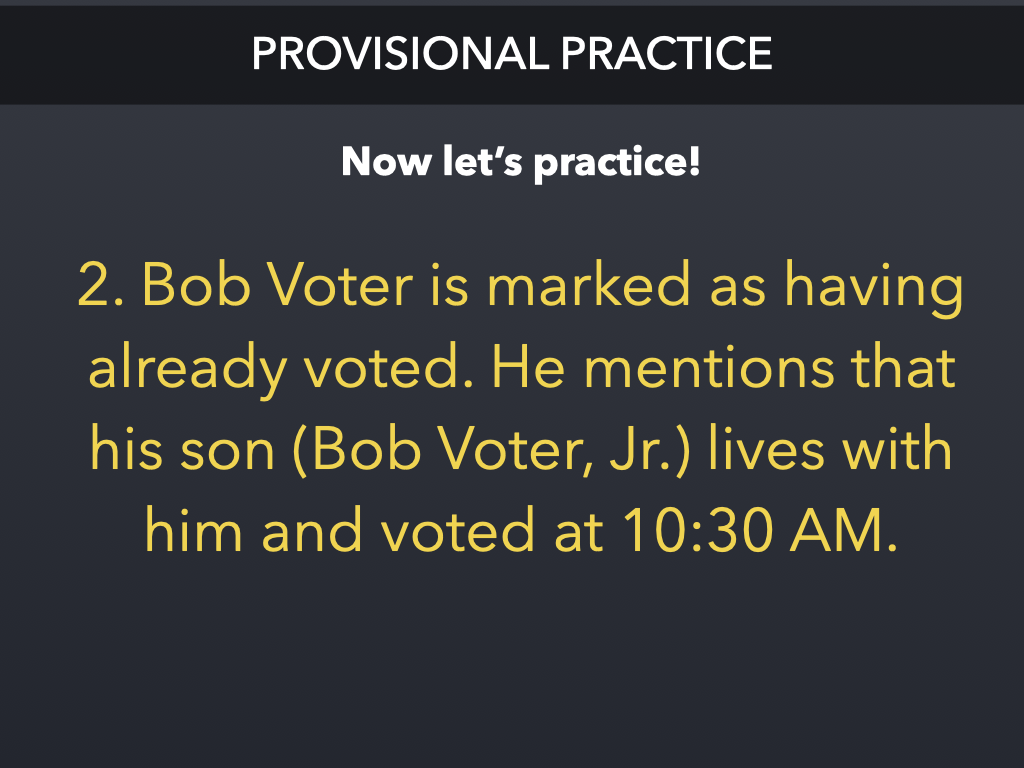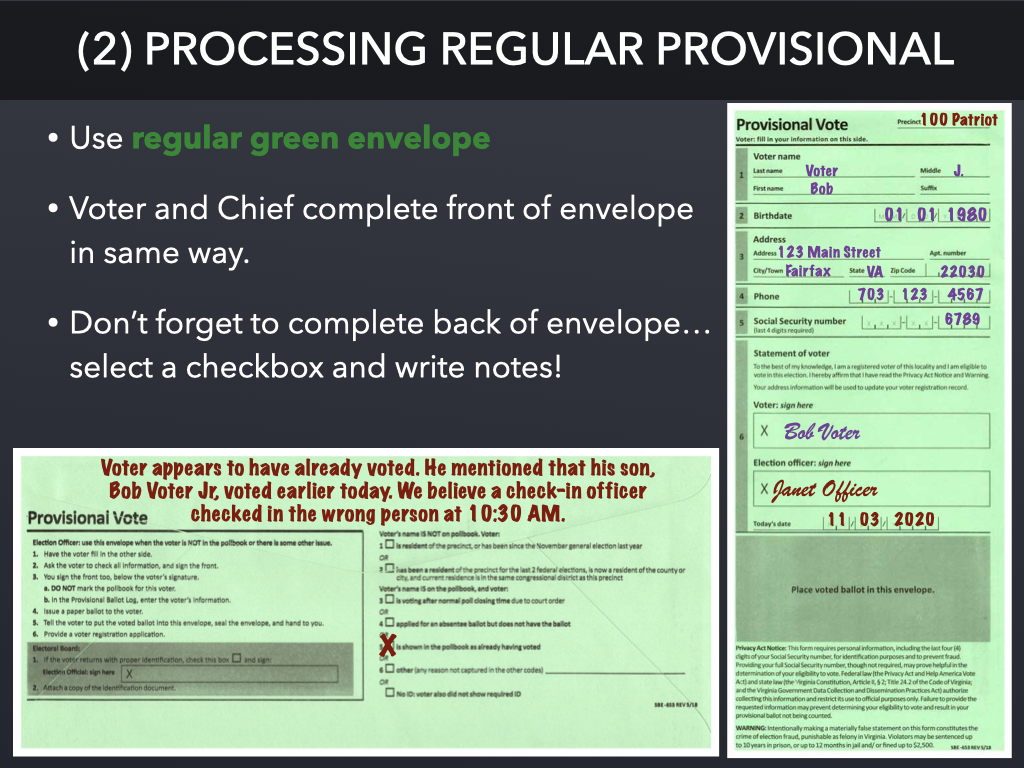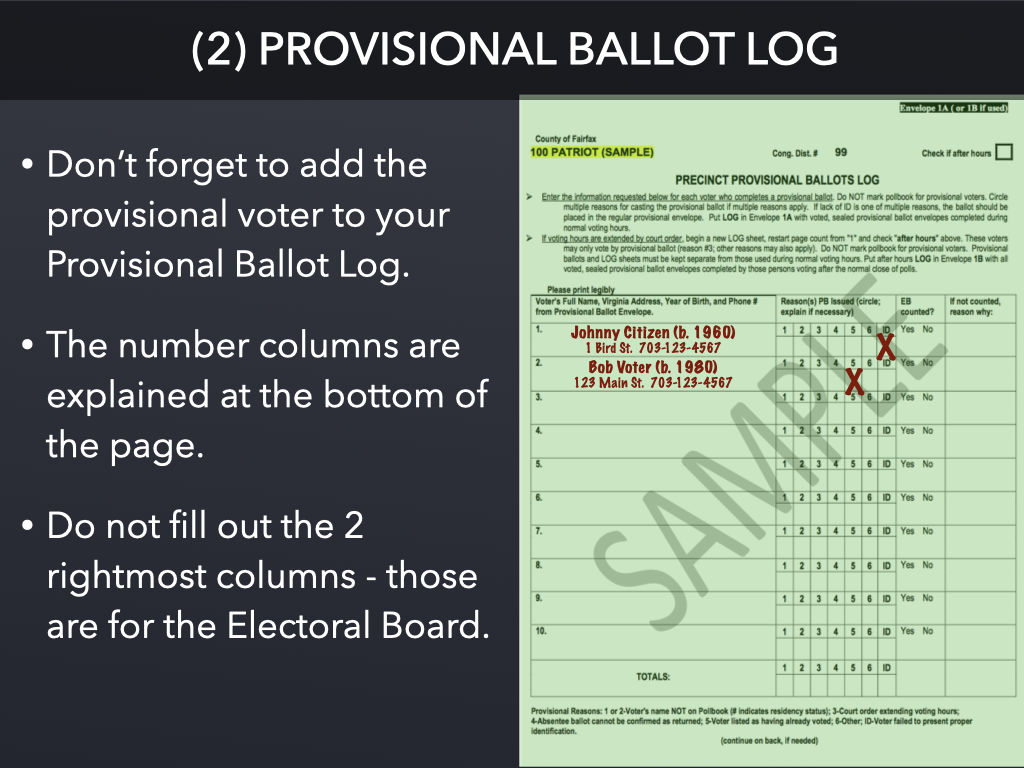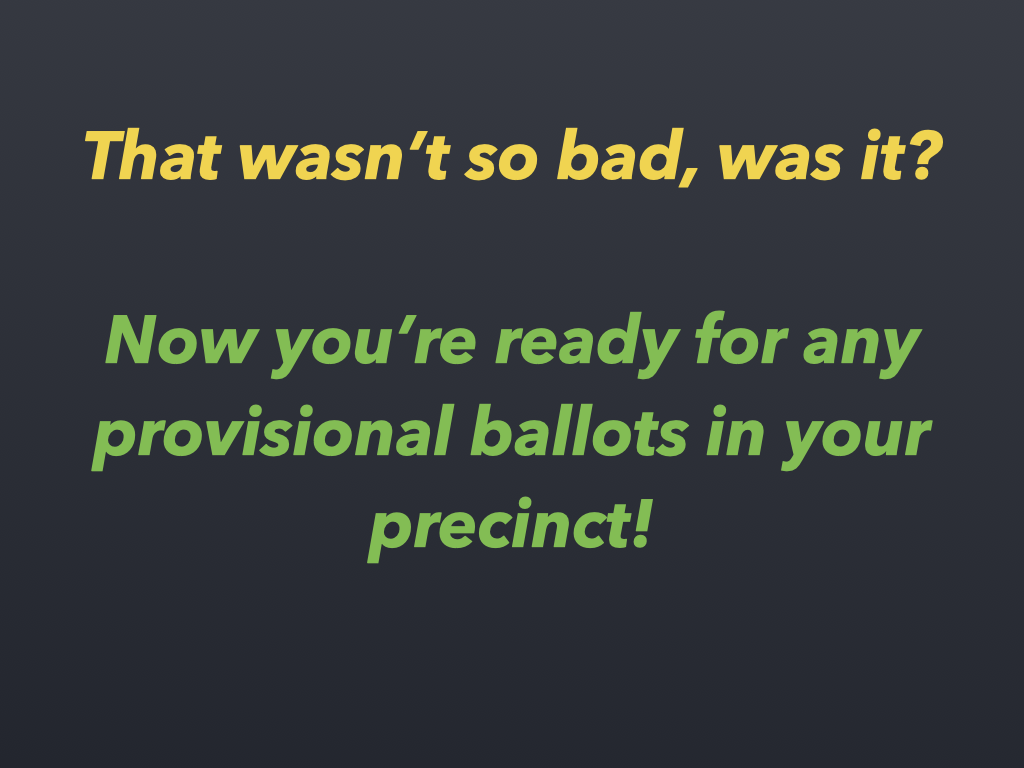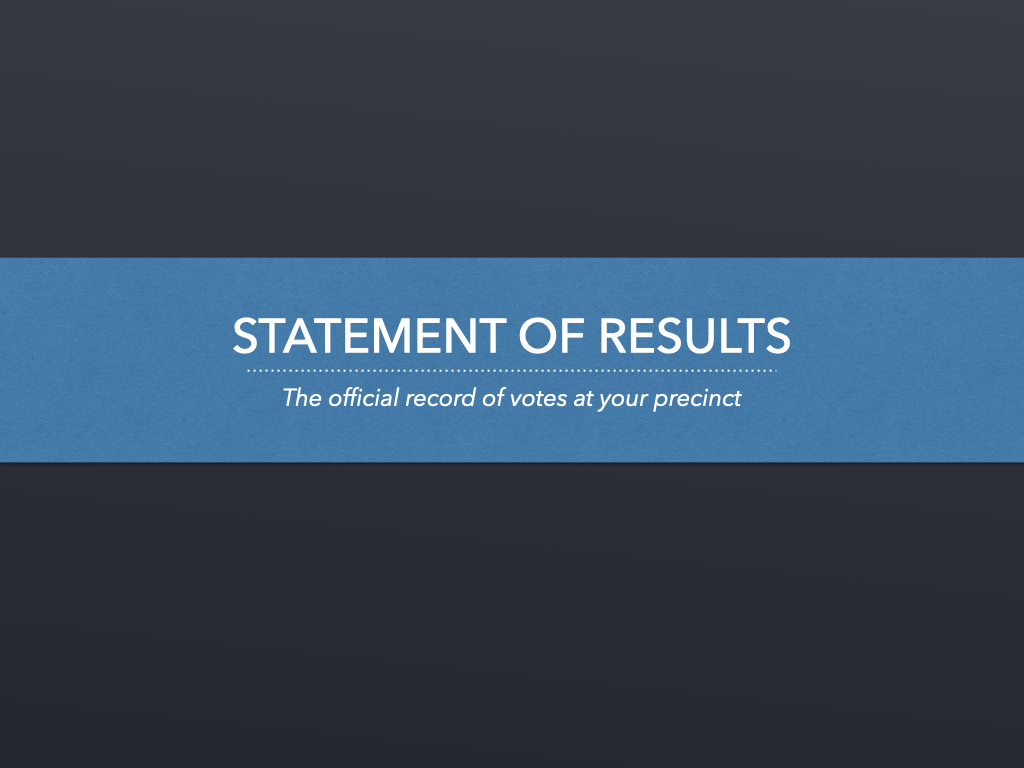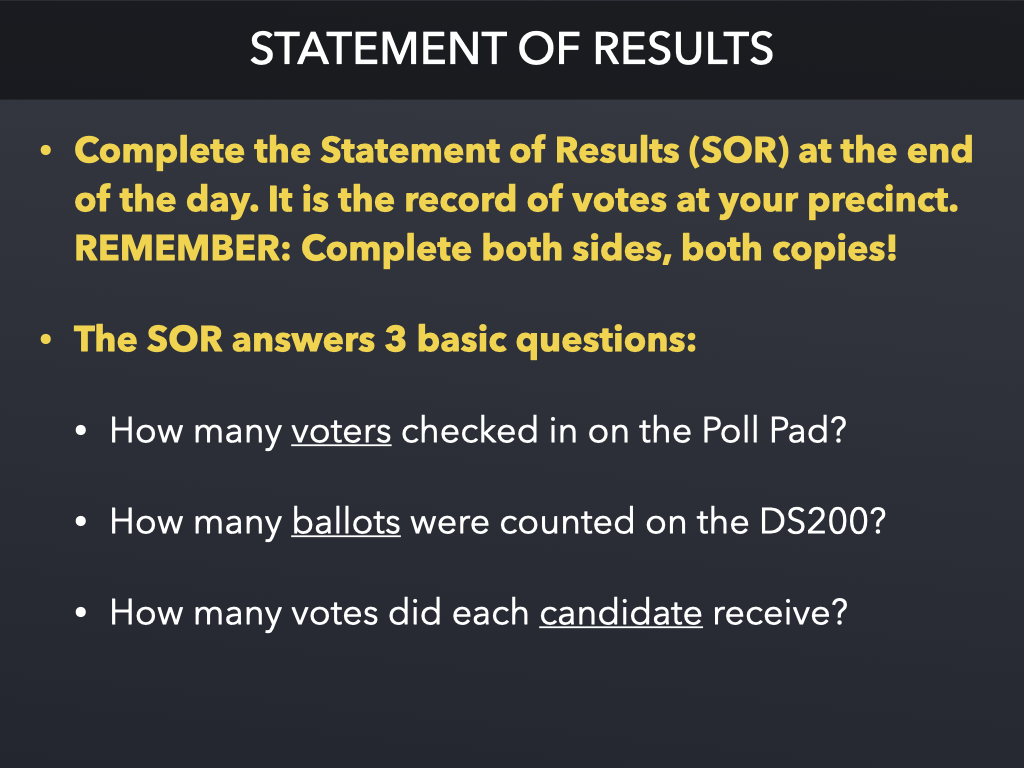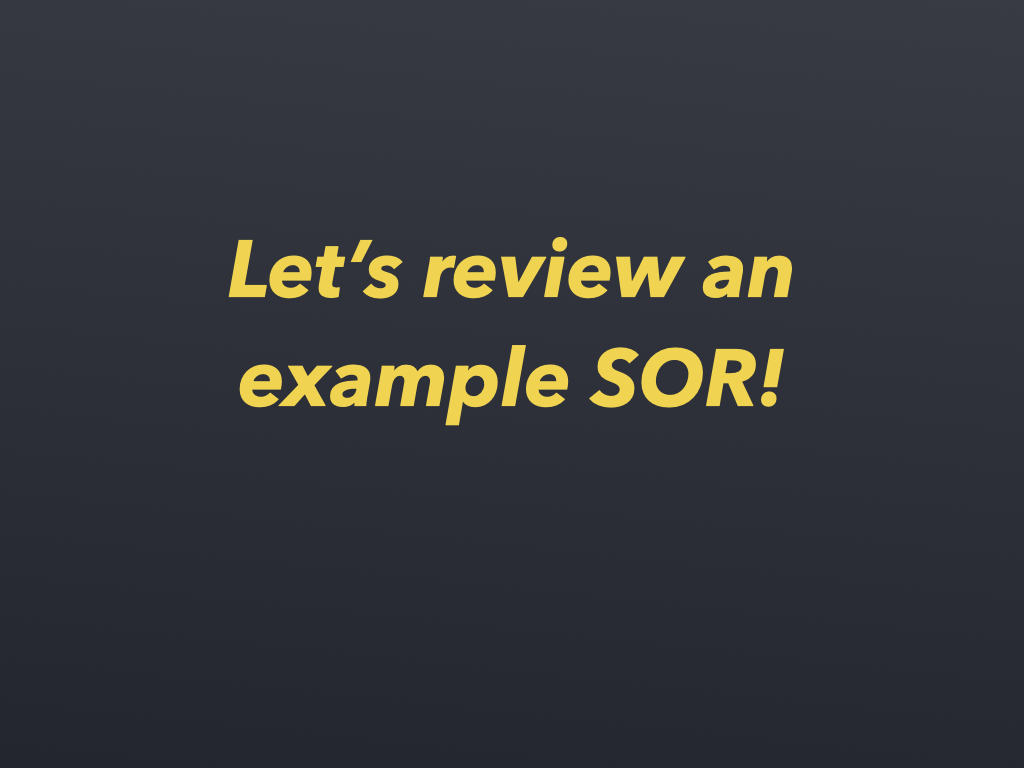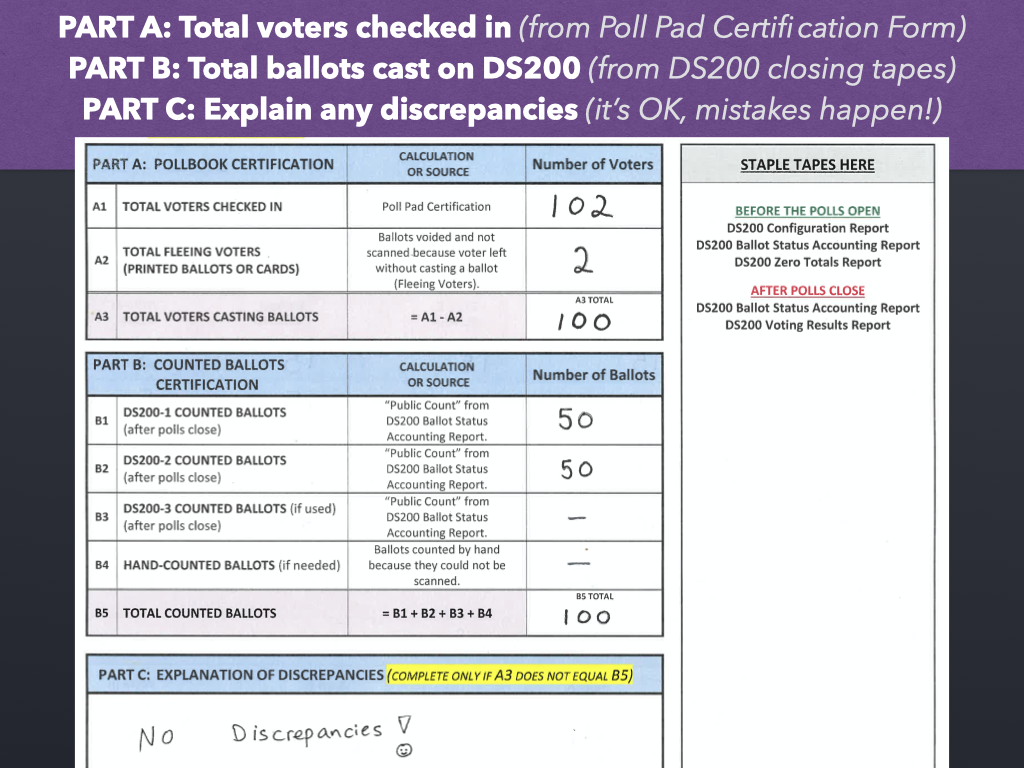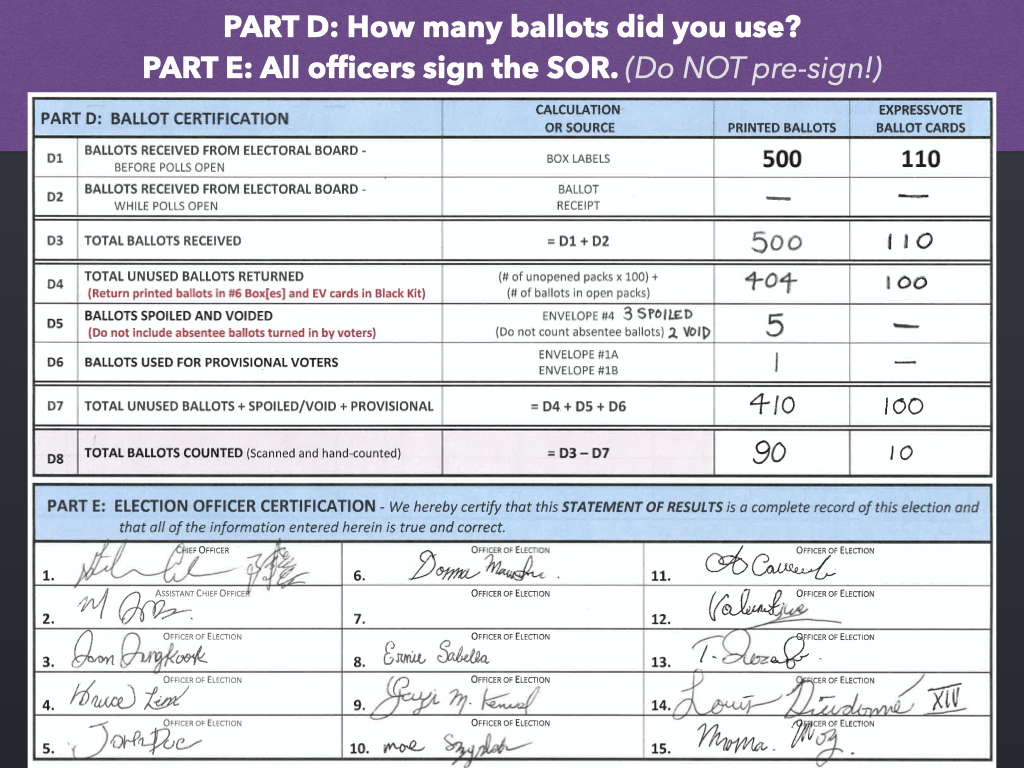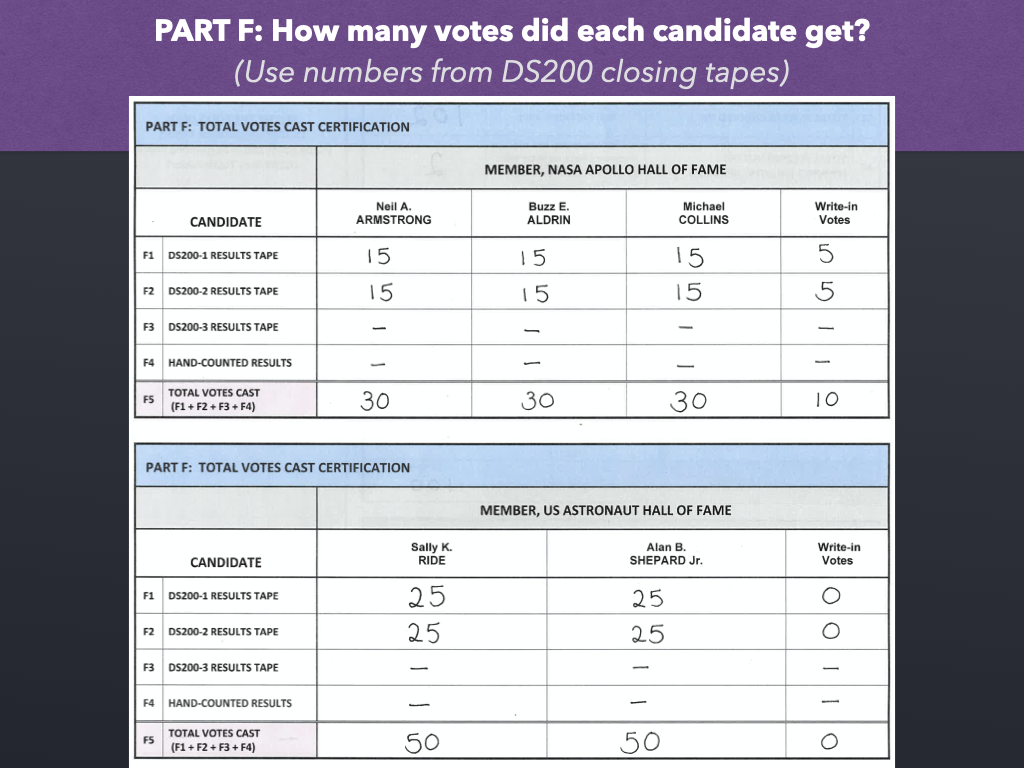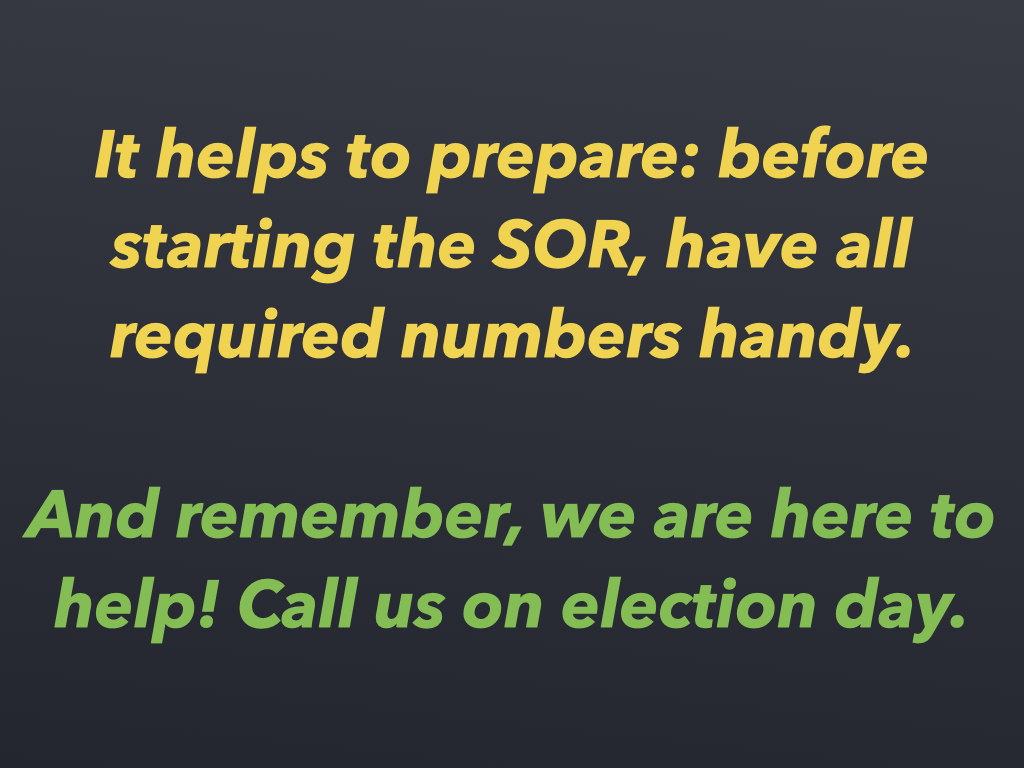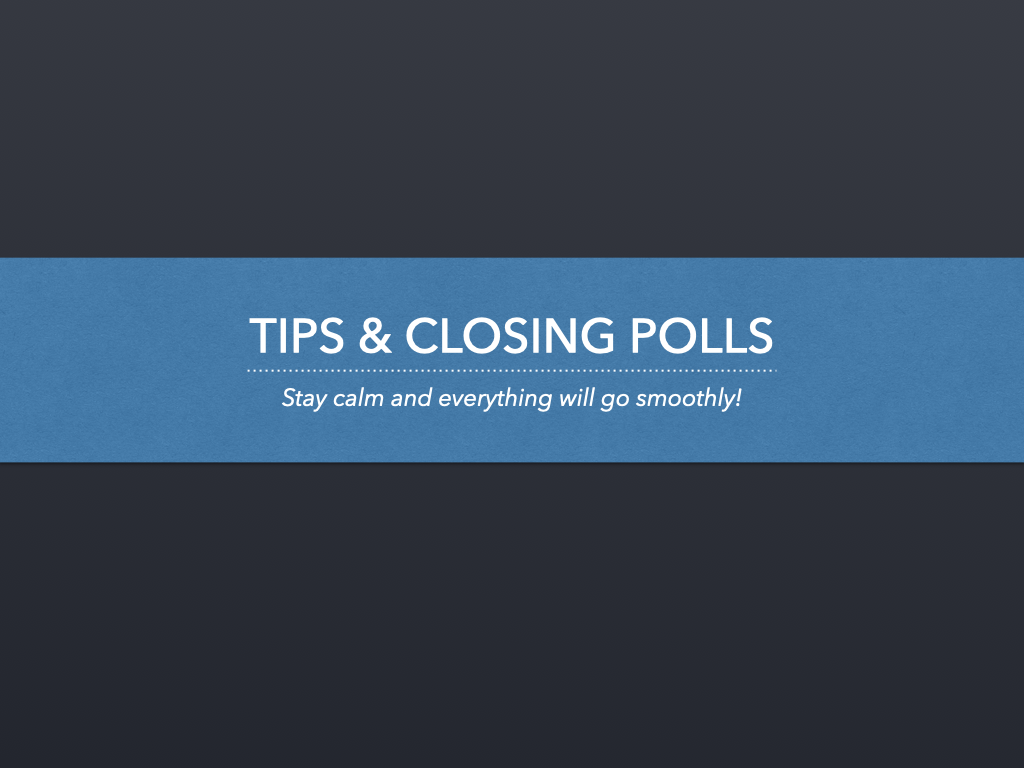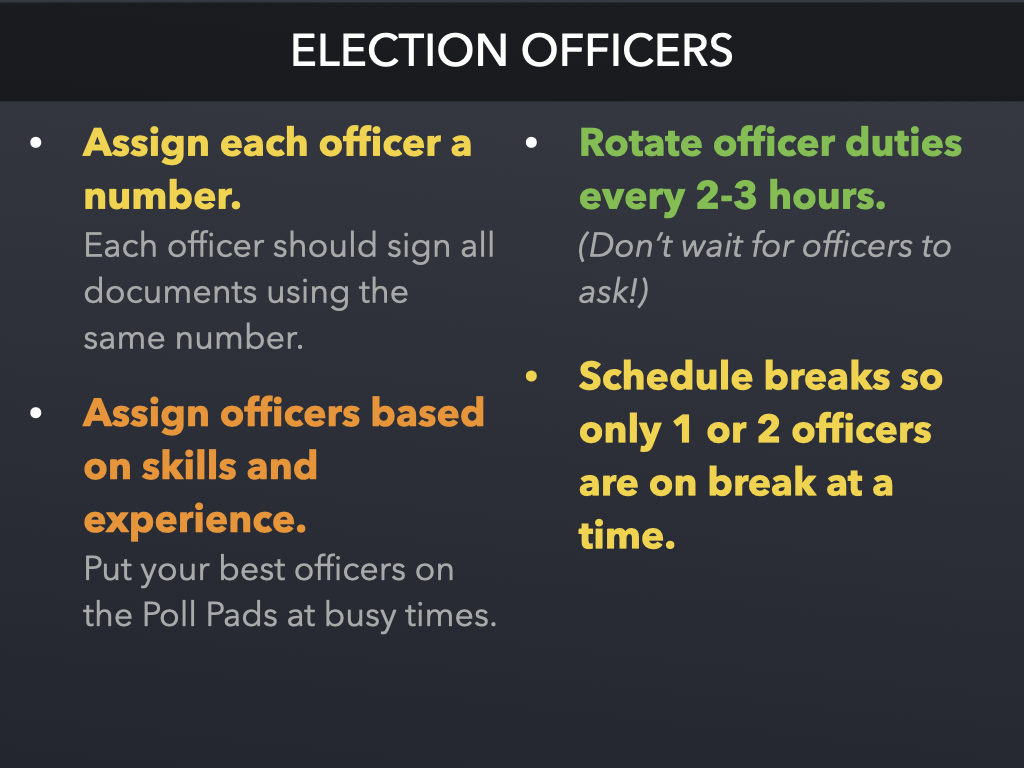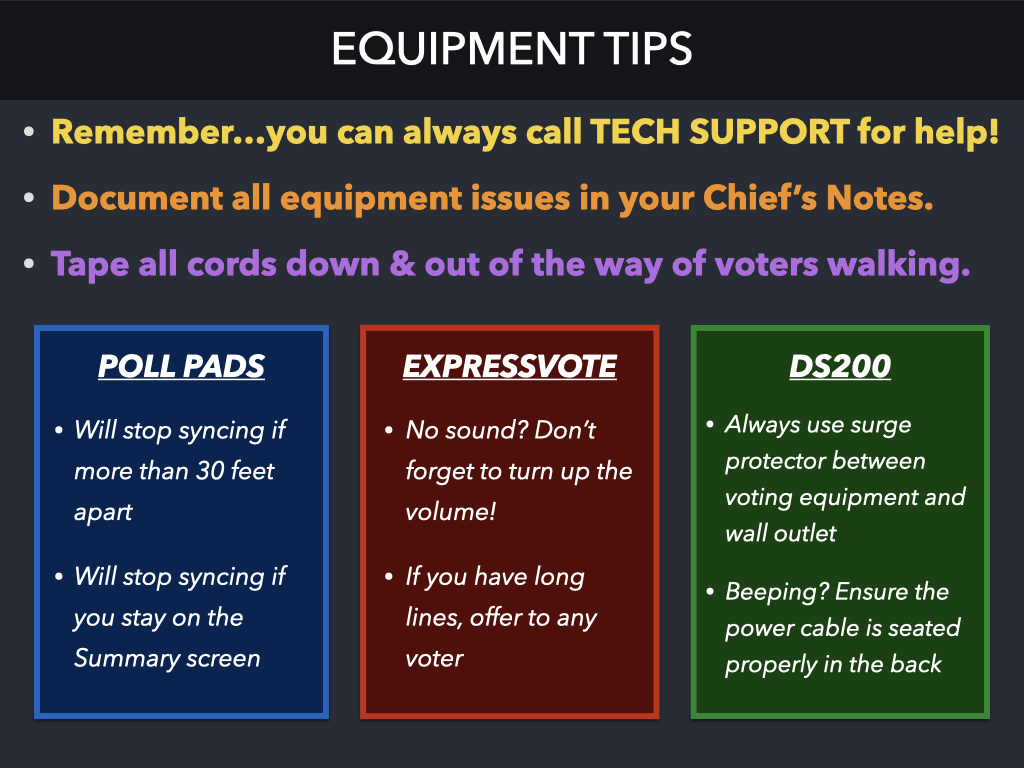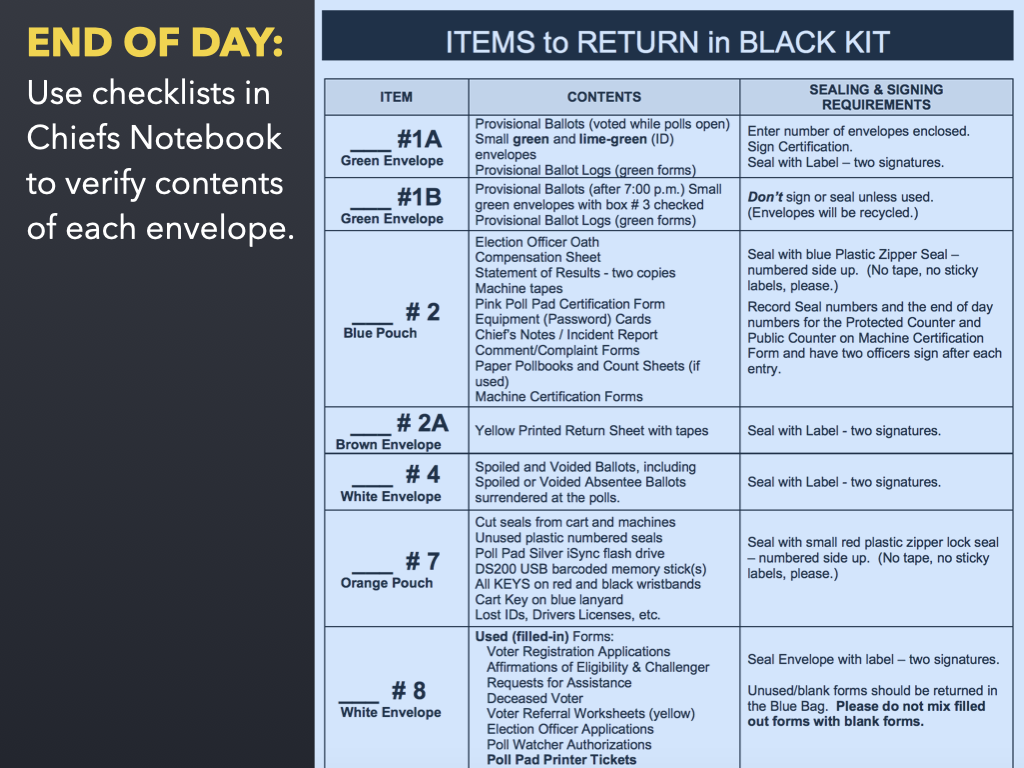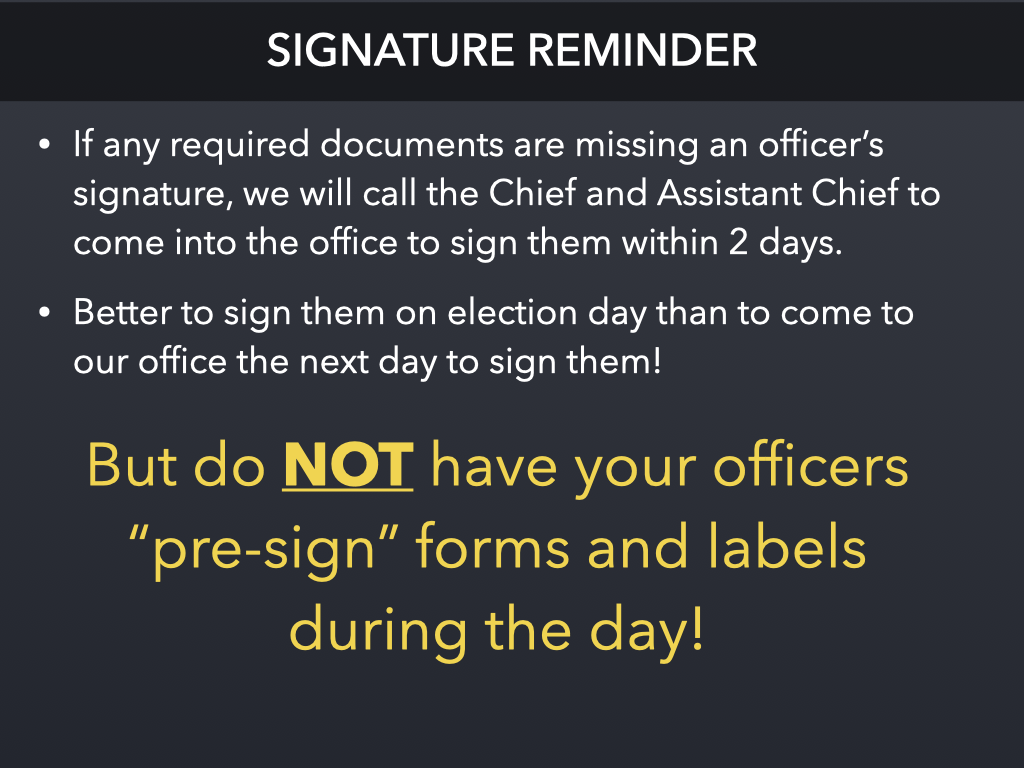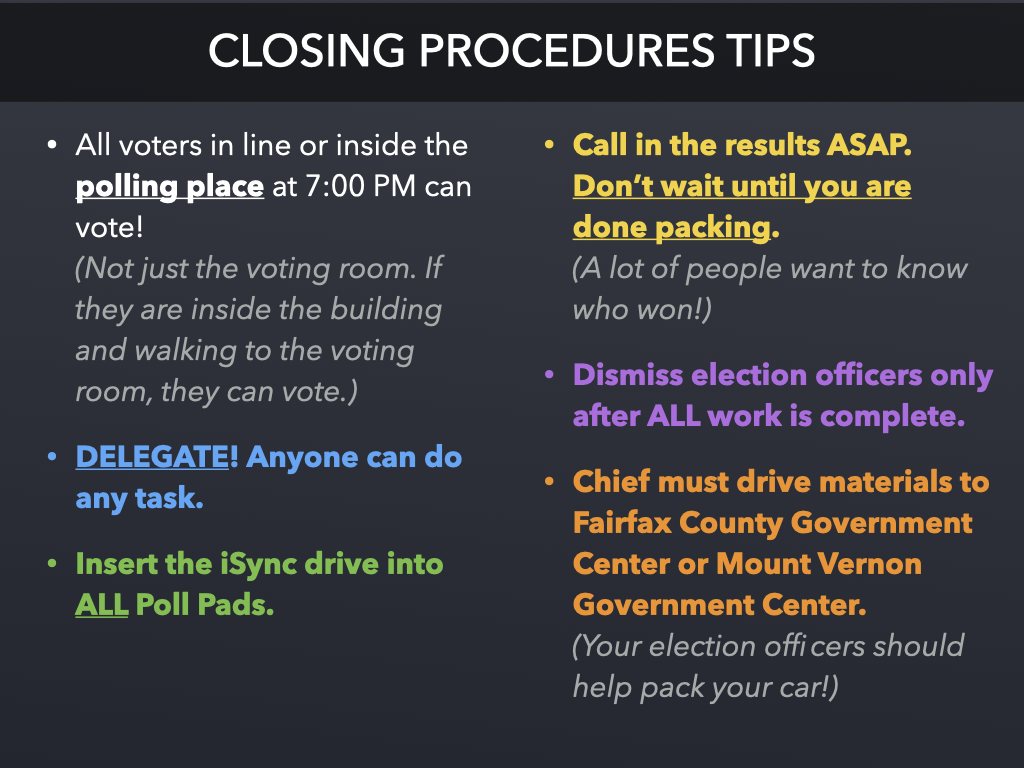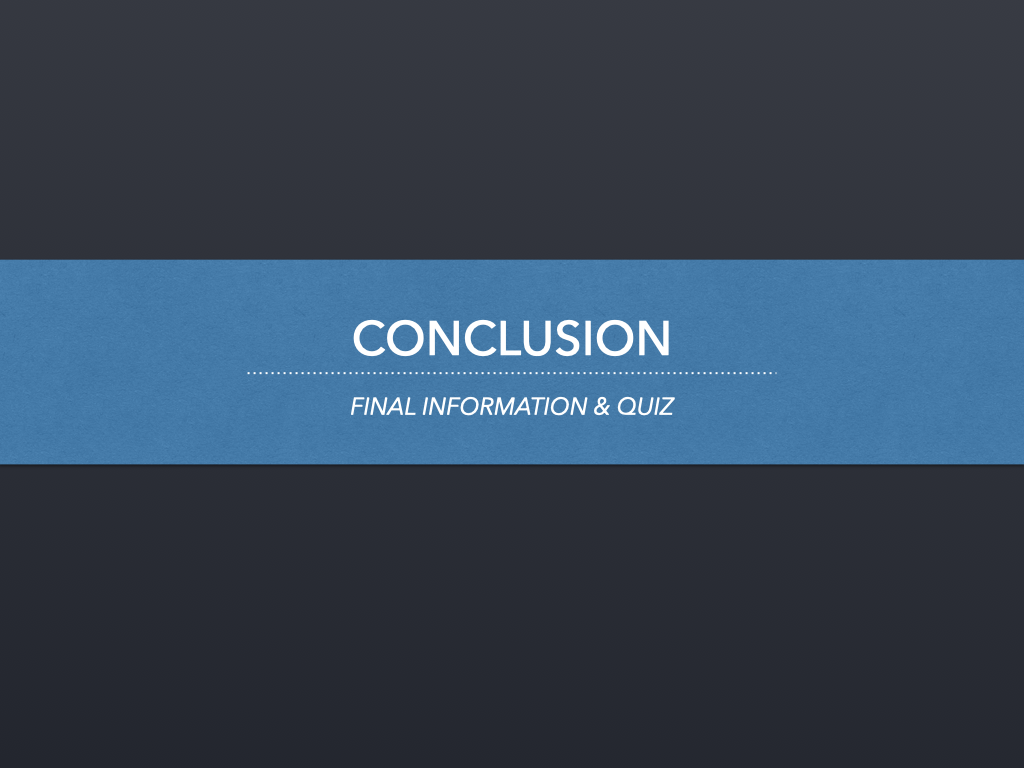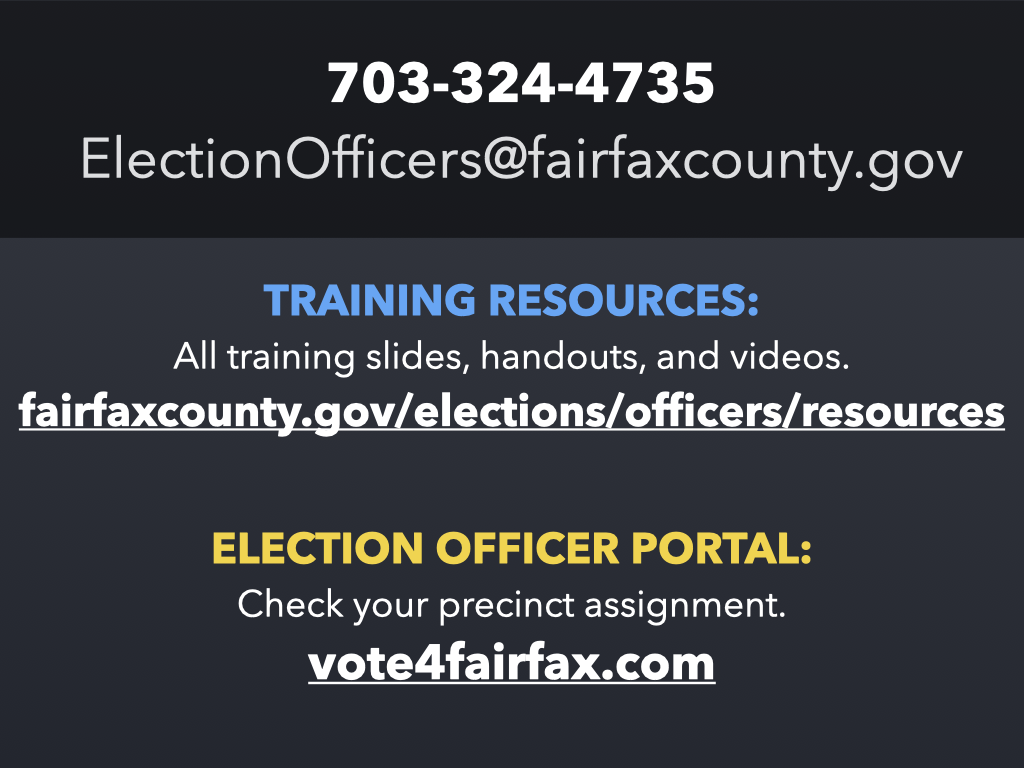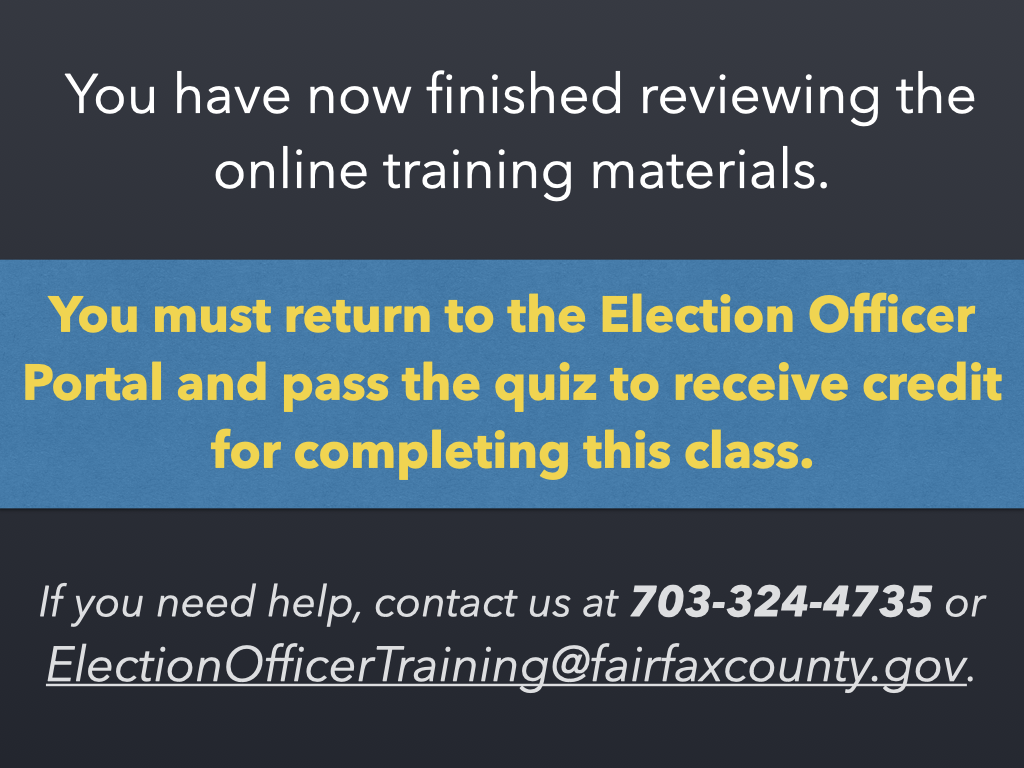Slides Summary
001. INTRO: June 2020
Welcome to the New Chief & Assistant Chief online training class!
This class will go over all information you need to know before serving as a Chief or Assistant Chief for the first time.
002. INTRO: Class Notes
Review all information in these slides and notes at your own pace.
We will go over all information you need to know, including what to do before polls open, how to handle non-routine voters, everything you need to know about provisional ballots, how to complete the Statement of Results, and how to close the polls at the end of election day.
At the end, you must complete a quiz to receive credit for this class.
003. INTRO: Election Officer Class Review
As all Chiefs and Assistant Chiefs must have previously served as an election officer, we will assume you are familiar with which IDs are acceptable, how to check in routine voters on the Poll Pad, and how to cast ballots on the DS200 scanner.
If you need a refresher, feel free to pause this training and view part or all of the online New Election Officer class.
004. INTRO: Contingency Response Plan for COVID-19
These training materials will prepare you for any upcoming election.
However, if you are reviewing this material in advance of the June 2020 Primary Elections, note that we are continuing to prepare and execute our Contingency Response Plan for COVID-19. As Chiefs and Assistant Chiefs, you will receive more detailed procedures during the pre-election briefing. All election officers will also be provided with detailed information about our Contingency Response Plan for COVID-19 before the election.
At minimum, we will provide a PPE Kit to each polling place with gloves, face coverings, hand sanitizer, and disinfectant for election officers. We will limit the number of voters in the voting room and require voters to maintain a 6-foot distance from each other and from election officers. And if any election officer is ill before or on election day, they will be dismissed immediately and replaced if possible.
005. BEFORE POLLS OPEN: Intro
We will now go over what to do before election day and during opening procedures before polls open.
006. BEFORE POLLS OPEN: Chiefs Notebook
The June 2020 Chiefs Notebook is available online here:
All Chiefs and Assistant Chiefs are issued a Chiefs Notebook before each election. This class is designed to give you an overview of everything you need to know, but you will also have your Chiefs Notebook on election day to easily double-check and reference how to handle any situation.
You will receive yours Chiefs Notebook about 1 week before election day. It’s very important for you to familiarize yourself with the content BEFORE election day, so you know where to look when you need to help a non-routine voter or handle a situation on election day.
007. BEFORE POLLS OPEN: The week before...
The week before the election, there are 3 things you need to do.
-
Attend a Chiefs Briefing. This is required, by law, before each election in which you serve as a Chief or Assistant Chief. At the Chiefs Briefing, you will learn about new laws and procedures that affect that election and you will receive your Chiefs Notebook and other election materials. Notably, Chiefs will receive a black rolling kit with many election documents and forms.
NOTE: For the June 2020 Primary Elections, the Chiefs Briefings will be held online. You will also schedule a time to pick up your election materials.
-
Visit your polling place. Sometime the week before the election, the Chief should visit your polling place to meet with building staff, see your voting room, and verify your gray equipment cart and DS200 scanners have arrived. The Assistant Chief should attend, if possible.
-
Chief contacts election officers. The week before the election, the Chief should send an email or call all election officers to go over basic information. This includes making sure each officer is still working, they know where the building is, they know which entrance to use, and they know which room is the voting room. If any officers says they are no longer able to serve, let the main office know immediately.
008. BEFORE POLLS OPEN: The day before...
There are 2 things to do the day before the election:
- Chief receives Sheriff’s Envelope. On the day before the election, Sheriffs will deliver an envelope to the Chief’s home between 6:00 AM and 2:00 PM. If you are not home, that’s OK — they will post it at your front door. This envelope will contain the iSync drive with the final voter file, along with other election materials. You must bring this envelope with you on election day! We suggest you put this envelope and your Chiefs Notebook in your black rolling kit, so you don’t forget them.
- Go to polling place, set up voting room. The day before the election, the Chief and Assistant Chief should go to the polling place and do initial setup of the voting room. Invite any available officers to join you! You should set up the overall room, including the tables, chairs, handouts, and indoor signs (do not post the outside signs as they could be moved or removed before election morning). You are allowed to open the gray cart and inspect or use the contents inside as long as you seal it again before you leave. The only exception is for ballots and voting equipment - do NOT open these before election day!
NOTE: For the June 2020 Primary Elections, it’s especially important to coordinate your setup time with your polling place. Some facilities, such as schools, have pre-determined time slots from which you must pick your setup time.
009. BEFORE POLLS OPEN: The morning of...
Now it’s election morning. What do you need to do?
- Swear in officers at 5:00 AM. Don’t wait for late officers; you can swear them in when they arrive. The important part is to swear in the officers who are present, so you can get started.
- Delegate tasks and work in parallel. Split up tasks among your officers and have them get started. Put your best officers on the most important tasks, including setting up the Poll Pads, setting up the DS200 scanners, and opening and counting the ballots.
- Open polls promptly at 6:00 AM. You must open the polls on time, even if you haven’t finished lower-priority tasks like putting up signs.
010. BEFORE POLLS OPEN: Voting Room Layout
This is a sample layout to give you an idea of how to setup your voting room.
- In this room, the voter enters, asks any questions of the Voter Information Officer, and then proceeds to the check-in table with the Poll Pads.
- If there are any issues checking in the voter, an officer would direct them to the Chief’s Table, where you may help resolve the issue.
-
After the voter is checked in, they move to the Ballot Table where they will receive their ballot. Each ballot is inserted in a privacy folder.
NOTE: For the June 2020 Primary Elections, we will not use a Ballot Table. To minimize interactions with voters, you should have your officers issue a ballot at the Check-In table.
- After receiving a ballot, the voter goes to the voting tables and sits in an empty privacy booth.
- If the voter elects to use the ExpressVote accessible marking device, an officer should guide them there. Note that the ExpressVote also has a privacy booth around it.
- Lastly, the voter moves to the DS200, scans their ballot, and exits the room.
The voting room should always be set up to have the voter move in a circular fashion, with an election officer at each station to help guide them.
011. BEFORE POLLS OPEN: Set up Chief's Table
As a new Chief or Assistant Chief, it’s vital that you set up your Chief’s Table with all items you may need. We suggest you actually use 2 tables: one to hold these documents and forms and another where non-routine voters may sit as you help them. You may want to have the forms table beside or behind you, depending on the room layout (you can also use the top of the gray cart).
- Voter Forms: Keep the different voter forms handy, including the Request for Assistance form for assisted voters, Affirmation of Eligibility for inactive voters, and Voter Registration Application for new or moved voters. We will go over these situations in more detail later in this training.
- Provisional Materials: Some non-routine voters may only be eligible to cast a provisional ballot. Keep your provisional log, provisional envelopes, and provisional notices handy for them.
- Numbered Envelopes: There are some numbered envelopes that you will put materials in throughout the day. For example, provisional materials go in envelope #1A, spoiled and voided ballots go in envelope #4, and completed voter forms will go in envelope #8.
- Chief’s Notes: This is where you will document any unusual situations or problems that occur on election day.
- Chiefs Notebook: Remember, you will have your Chiefs Notebook on election day, which will walk you through all situations that may arise, including how to help any non-routine voters and what forms they may need to complete.
- Poll Pad & Printer: You will have a special “Admin Poll Pad” and printer, which you should setup at your Chief’s Table. If needed, you can look up or check-in non-routine voters using this Poll Pad. It will sometimes print “tickets”, which you will return in envelope #8. If a voter is in the wrong precinct, it can also print directions to their registered polling place.
Keep your Chief’s Table tidy throughout the day. The better-organized your Chief’s Table is, the easier it will be for you to find what you need to help process non-routine voters!
012. BEFORE POLLS OPEN: People to know
Let’s go over some people who may be at your polling place:
- ROVERS: Rovers are Office of Elections staff who monitor and visit 10-12 polling places on election day. They may help with polling place or voting equipment issues. But for non-routine voter or provisional issues, you should always call the main office for help.
- NEWS MEDIA & INTERVIEWS: Remind your officers that they should call you if someone wants to do an interview. You may provide basic facts (e.g. number of voters checked in), but do not give opinions or forecasts. For anything further, call the Office of Elections.
- INSIDE - POLL WATCHERS: Authorized representatives of a party or candidate. Poll Watchers are allowed anywhere inside a polling place as long as they don’t impede voters or touch voting equipment. Poll Watchers may stay and observe closing procedures; but if they do, they cannot leave the room or report results early.
- OUTSIDE - POLL WORKERS, BAKE SALES, ETC.: Remember, state law does not permit loitering, congregating, or electioneering within 40 feet of a polling place entrance (i.e. the building entrance, NOT the voting room entrance). This means restricted activities like campaigning, handing out flyers, and bake sales must stay outside of the 40-foot Prohibited Area. You will receive a kit with a 40-foot rope, chalk, and tape to help you measure and mark your Prohibited Area. Check periodically throughout election day to make sure no one moves closer.
013. NON-ROUTINE VOTERS, PART 1: Intro
We will now go over some Non-Routine Voter situations and how to use the “What-Ifs” in the Chiefs Notebook.
014. NON-ROUTINE VOTERS, PART 1: Officers vs Chiefs
As a regular election officer in the past, you have helped process all routine voters. These are voters who can be checked-in on the Poll Pad without issue.
As a Chief or Assistant Chief now, you will help process all non-routine voters. If an election officer cannot check-in a voter, they will direct them to the Chief’s Table for you to help them.
015. NON-ROUTINE VOTERS, PART 1: Voter Referral Worksheet and What-Ifs
When one of your officers notices they have a non-routine voter, ask them to complete the yellow Voter Referral Worksheet and then refer the voter to you. You’ll notice that the list of reasons for referral on the left correspond with different What-If reference numbers on the right. You can use this information to look in the What-Ifs to find out how to handle any situation.
The What-Ifs are a comprehensive document with step-by-step instructions for dealing with any non-routine voter situation. You will reference them frequently on election day. If you have questions or need more help, you can always call our office and we will guide you through a non-routine voter situation.
016. NON-ROUTINE VOTERS, PART 1: State-issued document
We sometimes receive questions or suggestions about how to improve the What-Ifs. To be clear, the What-Ifs are a state-issued document that we have little ability to modify. But we want to do our best to help explain them in this training, so you know how to use them effectively on election day.
017. NON-ROUTINE VOTERS, PART 1: Poll Pad flags
As a reminder, when you check-in a voter on the Poll Pad, you are presented with different flags that you may select. For the next 3 non-routine voter situations, you will need to select one of these flags.
- If a voter requires assistance, you will select the Assisted flag.
- If a voter wants to vote curbside, you will select the Outside Polls (OP) flag.
- If a voter is Inactive, you will select the Voter Signed Oath flag.
- Remember, provisional voters are never checked-in on the Poll Pad, so you will not use the Provisional flag.
018. NON-ROUTINE VOTERS, PART 1: What if...voter is Inactive?
Voters can become “Inactive” if:
- They have moved, but did not update their voter registration.
- Or, if they have not voted in two consecutive federal elections, which occur in even-numbered years. For example, if someone did not vote in 2016 or 2018, they may now be marked as inactive.
How do you process an Inactive voter?
- First, ask the voter if they have moved. If the answer is yes, stop and use the Moving Conditions in the What-Ifs.
- Otherwise, simply ask the voter complete an Affirmation of Eligibility form. Now the voter can be checked-in.
- On the Poll Pad, select the Voter Signed Oath flag.
That’s it! One form and one flag on the Poll Pad. There’s no need to call the office for Inactive voters, but you can if you’d like help the first time.
019. NON-ROUTINE VOTERS, PART 1: Affirmation of Eligibility form
This is an example of an Affirmation of Eligibility form, which you will use for Inactive voters.
On the front side of the form, an election officer must complete Section A with some basic information like the precinct number & name and the date. Do not fill out the “Statement of Challenger” section for an Inactive voter - we will explain this section later in this training.
On the back side of the form, the voter must complete Section B with their information. This includes their name, signature, address, contact info, and more.
That’s it! Now the Affirmation of Eligibility form is complete and, as we mentioned, the voter may be checked-in on the Poll Pad and vote normally.
020. NON-ROUTINE VOTERS, PART 1: What if...voter needs assistance?
Some voters may need help to vote.
- A voter may have someone assist them in the voting booth with reading, translating, or marking the ballot.
- Almost anyone may assist a voter, including a friend, family member, or even an election officer. There are only 4 people who may not assist a voter: a candidate, a poll watcher, the voter’s boss, or the voter’s union representative.
- If a voter is assisted, the voter and their assistant must both sign the Request for Assistance form.
- There is one exception: if the assistant chosen by the voter is age 15 or younger, such as their child, neither the voter nor the assistant is required to complete the form.
How do you process an assisted voter?
- Ask the voter and their assistant to complete the Request for Assistance form.
- On the Poll Pad, select the Assisted flag.
NOTE: If a voter chooses to use the ExpressVote, no forms or Poll Pad flag are required.
021. NON-ROUTINE VOTERS, PART 1: Request for Assistance form
This is an example of a Request for Assistance form, which you will use for voters needing assistance.
In total, 3 people must mark this form:
- An election officer should write the precinct name and date at the top of the form.
- The voter must sign and print their name in Section A.
- The assistant must sign and print their name and address in Section B.
022. NON-ROUTINE VOTERS, PART 1: What if...voter is curbside?
Some voters may choose to vote curbside. They would pull into a designated curbside voter parking spot and call the phone number you have put on the curbside voting sign.
- Voters who are disabled or age 65 or older may request to vote outside the polls. You should not ask for additional proof if someone asks to vote curbside.
- The Request for Assistance form is NOT required for curbside voters. However, you may want to take this form with you when helping curbside voters in case they have someone in their vehicle who will be assisting them.
- In November elections, you may have high school pages assigned to your precinct. They may accompany you, but they may not directly help curbside voters.
NOTE: In most elections, two officers must go outside to help curbside voters. For the June 2020 Primary Elections, we are directing you to only send one election officer out to process curbside voters. It is simply not practical or reasonable for us to ask you to send two officers out for curbside voting during these difficult times.
How do you process a curbside voter?
- One officer goes outside to get the voter’s photo ID. Take an Assistance form (just in case), pen and pad to write down provided address, and a clipboard (do not bring the Poll Pad outside). Return inside to check-in the voter. Remember to select the “Outside Polls (OP)” flag on the Poll Pad.
- One officer goes outside with a ballot and stays until the voter completes it. Ask the voter to wait, then return inside to cast the ballot.
- An officer goes outside to inform voter their ballot has been successfully cast. (If the DS200 scanner did not accept the ballot, you would spoil the ballot and issue the voter a new ballot.)
Remember that you must always wait with the voter until they finish marking their ballot. If you do not stay, the voter could leave or give their ballot to an outside campaigner – don’t let that happen!
023. NON-ROUTINE VOTERS, PART 2: Intro
We will now go over some more Non-Routine Voter situations and how to use the “What-Ifs” in the Chiefs Notebook.
024. NON-ROUTINE VOTERS, PART 2: A note about provisional ballots
Many of the following situations will involve provisional ballots.
The first step is to understand WHEN to offer a provisional ballot to a voter.
After this section, we will explain HOW to complete a provisional ballot step-by-step.
025. NON-ROUTINE VOTERS, PART 2: What if...voter has no ID?
If a voter does not have an acceptable ID with them, they still have multiple options to vote.
- The voter can retrieve their ID, if it’s simply in their car or at home, or the voter can get a temporary ID from the Office of Elections.
- However, you should always offer the voter a provisional ballot. Many voters say they will return, but they don’t!
Provisional ballots are ballots that are set aside on election day and adjudicated later. There is a common misconception that provisional ballots are only counted in close races or to break ties; this is not true! Provisional ballots are reviewed by the Electoral Board in the days after the election and, if counted, they are included in the official election results.
NOTE: You may have heard the law regarding photo IDs recently changed. This does not take effect until July 1, 2020, which is after the June primary election. We will provide more information about the exact changes at that time.
026. NON-ROUTINE VOTERS, PART 2: What if...voter is already checked in?
What should you do if a voter is already listed in the pollbook as having voted earlier in the day?
- This may have happened if one of your officers checked in someone manually with the wrong name. For example, Bob Voter, Jr. arrived to vote, but was checked-in as Bob Voter.
- Unless both voters are present, do NOT edit the previous check-in.
- Instead, offer the voter a provisional ballot.
The Electoral Board will review the situation and determine if the ballot should be counted.
027. NON-ROUTINE VOTERS, PART 2: What if...voter is not in pollbook?
What should you do if a voter is not listed in the pollbook?
- First, try doing an advanced search on the Poll Pad to try and find the voter by their address or other identifying information.
- If you still can’t find the voter, call the Office of Elections. It may be an error and the office may give you instructions on how to add the voter to your pollbook.
- Otherwise, offer the voter a provisional ballot.
The Electoral Board will review the situation and determine if the ballot should be counted.
028. NON-ROUTINE VOTERS, PART 2: What if...voter requested an absentee ballot?
What if a voter requested a mailed absentee ballot, but then comes to the polling place anyways?
First, let’s look at the steps if the voter comes to the polling place WITH their absentee ballot.
- First, the voter should surrender their ballot to you. If it is still sealed in the envelope, ask them to open the envelope to verify the ballot is present. If the voter has made selections in any contest, ask them to fill in all bubbles for those contests, so no one knows who they intended to vote for.
- Next, you must write “absentee spoiled” across the face of the ballot. Place this ballot in envelope #4 with other spoiled and voided ballots.
- Now you may check-in the voter on the Poll Pad and allow them to vote a regular ballot.
Now let’s look at the steps if the voter comes to the polling place WITHOUT their absentee ballot.
- This one is very straightforward: simply offer the voter a provisional ballot.
- Office of Elections staff will verify that the voter did not already vote an absentee ballot in-person or by mail.
NOTE: For the June 2020 Primary Elections, many more voters than usual have requested an absentee ballot and we expect an increase in the number that will show up at polling places. Make sure you understand this What-If situation and feel free to call our office before election day for any questions.
029. NON-ROUTINE VOTERS, PART 2: What if...voter is challenged?
It is rare, but you may have someone challenge a voter’s eligibility to vote.
- Any registered voter (including an election officer) may challenge another voter. This may happen if they believe the voter is not who they say they are or they have reason to believe the voter does not live at their registered address.
- In this case, we will use the Affirmation of Eligibility form. You may remember that this was the same form used for Inactive voters.
- An election officer fills in the precinct and date.
- The challenger completes and signs the front page of the form.
- The voter completes and signs the back page of the form. Once they do so, they are permitted to vote a normal ballot. If they decline to sign the form, they may complete a provisional ballot or choose not to vote.
Again, this is a rare situation but if it happens, feel free to call the office for help.
030. NON-ROUTINE VOTERS, PART 2: What if...voter has P.O. Box?
Some voters may be listed in the pollbook with a P.O. Box instead of a typical address. That’s OK!
- During the check-in process, as long as the address the voter provides orally or in writing matches the address listed in the Poll Pad, you should check them in routinely.
- Individuals registered with a P.O. Box are known as Protected Voters. They may be law enforcement personnel or other individuals who need to keep their residential address private.
- To be clear, you do NOT need a provisional ballot.
Again, as long as the voter provides the same address as in the pollbook, you should always check-in the voter routinely. There is no need to call the office for this situation.
031. NON-ROUTINE VOTERS, PART 2: What if...voter is in the wrong precinct?
What if someone shows up to vote, but they are not registered in your precinct?
- First, you should strongly encourage them to go to the correct precinct, if possible. Virginia law states that you must vote in your registered precinct on election day.
- If the voter is not able to go to the correct precinct in time, then as always, offer a provisional ballot. All provisional ballots are adjudicated by the Electoral Board.
Note that the Admin Poll Pad at the Chief’s Table can print directions from your polling place to the voter’s correct polling place, which you can give the voter. Again, you should do everything possible to get the voter to their registered precinct, where their ballot has the best chance of being counted.
TIP: You can write your name, title, and phone number on the back of the printed directions slip so the voter can show that to the Chief at the other precinct in case there are any questions.
032. NON-ROUTINE VOTERS, PART 2: What if...voter has moved?
If a voter has moved, you will frequently consult the Moving Conditions on page 9 of the What-Ifs. These can often be the most confusing thing for a new Chief or Assistant Chief, but we’re going to walk you through it!
First, you should ask the voter when exactly did they move. Once you know the date they moved (or at least the month and year), you will look for the correct row that matches. For example, a voter who has moved in 2020 would be in the row that is for “after 11/5/2019”.
Next, you need to determine how far the voter has moved. If they moved within the same precinct, we can look towards the leftmost column in green and see they can always vote. Similarly, if they have moved out-of-state, we can see the rightmost column in red and see they cannot vote normally (however, you should always offer a provisional ballot).
The hard part is when they have moved within Fairfax County. You will need to determine the Congressional District of their old and new precincts. You can either call our office or visit www.house.gov on your phone. Depending on if they moved within the same congressional district or into a different congressional district, you would look in the corresponding columns and find out if they can vote.
Generally speaking, a voter who has moved will have to go to their registered (“old”) precinct.
033. NON-ROUTINE VOTERS, PART 2: Moving situation (moved to Maryland)
Let’s take a look at an example situation. What if a voter moved in July 2018 to Maryland?
- First, we look for the row that matches the moving date. July 2018 is between 11/9/2016 and 11/5/2019, so we are looking in the middle row.
- Next, we look for the column that matches how far the voter moved. In this case, they moved to another state, which is the rightmost column.
- Therefore, we can see that “No”, they cannot vote routinely. But again, you should always offer a provisional ballot to the voter.
As you can see on the chart, no matter when a voter moves out-of-state (even if it was the day before the election), they are not eligible to vote routinely in Virginia anymore.
034. NON-ROUTINE VOTERS, PART 2: Moving situation (moved within Fairfax County)
Let’s take a look at another example situation. What if a voter moved in May 2017 to another precinct in Fairfax County? For the purposes of this example, let’s assume they moved within the same congressional district.
- First, we look for the row that matches the moving date. May 2017 is between 11/9/2016 and 11/5/2019, so we are looking in the middle row.
- Next, we look for the column that matches how far the voter moved. In this case, they moved within Fairfax County and within the same congressional district, which is the second column.
- Therefore, we can see that they can vote in their “old” precinct if otherwise eligible.
As you can see on the chart, if a voter has moved within Fairfax County, the date when they moved is very important. Whether or not they are permitted to vote routinely, you should offer them a Voter Registration application so they may update their registered address.
035. NON-ROUTINE VOTERS, PART 2: Voter Registration Application
Here is a sample of a Virginia Voter Registration Application. This form is used for new voters, as well as voters who simply need to update their name or address.
Whenever you have a voter who has moved without updating their voter registration, you should always offer them a Voter Registration Application. If they complete it and turn it in to you, you may return it in envelope #8 and our office will process it shortly after the election.
036. NON-ROUTINE VOTERS, PART 2: Mini-review
Let’s do a quick review! Take a moment to think about these questions before you read the answer below.
- What 3 tasks should you complete approximately one week before election day? You should attend a Chiefs Briefing, visit your polling place, and the Chief should contact all election officers.
- Do Inactive voters (who have not moved) vote normally or provisionally? Inactive voters can vote NORMALLY after they complete an Affirmation of Eligibility form.
- What should you do if a voter brings their mailed absentee ballot with them? If a voter brings their mailed absentee ballot, they should surrender it to you. You will mark it as “absentee spoiled” and then allow the voter to vote normally.
- What should you do if you’re not 100% sure how to handle a voter who has moved or other non-routine situations? Call the office! We are here to help. The most important thing is to make sure we process each voter correctly. And once you feel more comfortable, you will be able to process most non-routine voters yourself.
037. PROVISIONAL BALLOTS: Intro
We will now go over Provisional Ballots and the step-by-step procedures for issuing them to voters.
038. PROVISIONAL BALLOTS: The role of the Electoral Board
Before we begin, a very, very important note about provisional ballots…
The Electoral Board — and only the Electoral Board — decides whether to count provisional ballots. You should never tell anyone their ballot will or will not be counted. That is the Electoral Board’s decision!
If a voter wants more information, you can tell them to call our office.
039. PROVISIONAL BALLOTS: Reminders
Also, a reminder that you should NOT check-in provisional voters on your Poll Pad. Unfortunately, at this time we are unable to disable the provisional flag on the Poll Pad software as it is used by many jurisdictions and states whose laws are slightly different than ours. But in Virginia, provisional voters are never marked on the pollbook because we do not know yet if their ballot will be counted.
In addition, do NOT let voters cast provisional ballots on the DS200 scanner. It’s very important to help provisional voters at the Chief’s Table, far away from the DS200 scanner. Once you issue a ballot to a provisional voter, stay with them until they place it in the provisional envelope and return it to you.
040. PROVISIONAL BALLOTS: Two kinds of provisional ballots
There are 2 kinds of provisional ballots. They both use slightly different shades of green.
- If a voter has no ID, you will use the lime green envelope on the left.
- For registration, absentee, and other issues, you will use the regular green envelope on the right.
Generally speaking, only about 15% of provisional voters are because they do not have their ID, while 85% are for other issues. So for the most part, you will be using the regular green envelope.
041. PROVISIONAL BALLOTS: Important notes
A few very important notes about provisional ballots:
-
Virginia law requires both the voter AND the election officer to sign the provisional envelope. Not signing is the most common mistake we see with provisional ballots - don’t let that happen in your precinct!
-
If you have additional information about why the voter is voting provisionally, you should put it on the OUTSIDE of the envelope. You can write on the envelope or you can staple notes. This is because the Electoral Board cannot open an envelope until they have already decided to count it. If you or the voter put any notes inside, the Electoral Board will not be able to see them before they make their decision.
-
Once someone has voted provisionally, they may NOT vote normally later that day. A provisional vote counts as your one vote for the day. If a no-ID provisional voter later returns with a copy of their ID, you can attach it to their provisional envelope. But you cannot open or discard the provisional envelope and let the voter vote normally, per state law. And in Fairfax County, we do something funny - we follow the law!
042. PROVISIONAL BALLOTS: Provisional notice
This is a sample of a provisional notice. You must give each provisional voter this notice, which tells them more about how and when their provisional ballot will be adjudicated.
For no-ID provisional voters, it also outlines the ways they can submit a copy of their ID to have it be counted. A voter can submit their ID by email, by fax, in-person at our office, or by postal mail. We strongly encourage you to remind voters that email may be the easiest option - they could go home, take a picture of their ID on their phone, and email it to us.
043. PROVISIONAL BALLOTS: Provisional Ballot Log
This is a sample of the Provisional Ballot Log.
For each provisional voter, you will record some basic information about them here, including their name, address, year of birth, and phone number. The voter writes this information on the individual provisional envelopes, so you can simply copy it over.
You must also select a numerical reason code for each provisional voter - these are listed at the bottom of the page and on the individual provisional envelopes.
NOTE: For the June 2020 Primary Elections, it is likely the most common reason code you will use is #4, for voters who don’t bring their absentee ballot with them.
Leave the two rightmost columns blank - those are reserved for the Electoral Board.
044. PROVISIONAL BALLOTS: Step-by-step
Let’s go over all the steps involved in processing a provisional voter. To start, they should be sitting with you at the Chief’s Table.
- First, explain the process and give the provisional notice to the voter. (The reason we do this first is so we don’t forget!)
- Next, have the voter complete the provisional envelope. Remember, you must also sign the envelope.
- Next, add the voter to the Provisional Ballot Log.
- Next, have the voter fill out a ballot while at the Chief’s Table. You should stay with them, so they don’t accidentally walk over to the DS200 scanner and try to cast their ballot normally.
- Once the voter has marked their ballot, seal it in the small green provisional envelope.
- Finally, place the individual provisional ballot envelope in the large green #1A envelope. All provisional envelopes are returned here.
You’ll note that the ballot was the last thing you and the voter complete. By doing the other steps first, you’re making sure you don’t miss or forget anything.
045. PROVISIONAL BALLOTS: Practice situation #1
Now, let’s practice a provisional situation!
Johnny Citizen wants to vote, but the only photo identification he has with him is a Costco membership card.
As you know from being a regular election officer, a Costco membership card may have a photo but it is NOT an acceptable ID for voting. If this voter does not have another valid ID with them, you should offer them a provisional ballot.
046. PROVISIONAL BALLOTS: Filling out a no-ID provisional envelope
Let’s continue the example with a voter with no acceptable ID.
- Because this is a no-ID provisional situation, you will use the lime green envelope.
- The officer helping the provisional voter completes 3 fields: the precinct number and name in the top right, their signature, and today’s date towards the bottom.
- The voter completes all other fields, including their name, address, and date of birth. And don’t forget the most important thing - check to make sure the voter signed the envelope!
Do not mark or write anything on the back of the no-ID provisional envelope. That is for the Electoral Board.
047. PROVISIONAL BALLOTS: Adding a no-ID provisional voter to the Provisional Ballot Log
Don’t forget to add the provisional voter to your Provisional Ballot Log!
Again, you will copy over some basic info and select a reason code. In this case, the voter has no ID, which means you mark an ‘x’ in the “ID” column. (This is explained in the small text at the bottom of the page.)
Leave the two rightmost columns blank for the Electoral Board to use.
048. PROVISIONAL BALLOTS: Practice situation #2
Now, let’s practice another provisional situation!
Bob Voter comes in the afternoon, but is marked as having already voted. He mentions that his son (Bob Voter, Jr.) lives with him and voted earlier that day around 10:30 AM.
As we discussed in the Non-Routine section, this is most likely due to an officer checking in the wrong voter. Because you cannot edit the previous check-in, you must offer the voter in front of you a provisional ballot. The Electoral Board will then review the situation and determine if his ballot should be counted.
049. PROVISIONAL BALLOTS: Filling out a regular provisional envelope
Let’s continue the example with a voter who is already marked as having voted.
- Because this is NOT a no-ID provisional situation, you will use the regular green envelope.
- Here, the voter and officer again complete the front of the envelope, including signatures from each person.
- In this situation, you must also complete the back of the envelope - select a checkbox and write notes!
- Here, we have selected reason code #5 (voter is showing in the pollbook as already having voted) and wrote some notes at the top of the envelope to explain that we think we checked in his son by mistake earlier in the day.
Remember, any notes should be written or attached to the outside of the envelope, so the Electoral Board can review them before they make their decision. You may offer the voter a separate piece of paper for them to write their own notes, then staple it to the envelope.
050. PROVISIONAL BALLOTS: Adding a regular provisional voter to the Provisional Ballot Log
Again, don’t forget to add this provisional voter to your Provisional Ballot Log!
For this voter, just as you selected reason code #5 on the envelope, you will mark an ‘x’ in the #5 column.
051. PROVISIONAL BALLOTS: Now you're ready!
That wasn’t so bad, was it? Now you’re ready for any provisional ballots in your precinct!
The hardest part is understanding when a provisional ballot should be issued and then the basic overview of how to issue a provisional ballot to a voter. And if you need help on election day, remember that you can always call the office for help.
052. STATEMENT OF RESULTS: Intro
We will now go over the Statement of Results and how to complete it election night.
053. STATEMENT OF RESULTS: Overview
The Statement of Results is the most important document you will complete on election night because it is the record of votes in your precinct.
The SOR, as it’s often called, is usually two pages, front and back. There will also be an identical SOR Copy that you will also complete (the official SOR goes to the courthouse while the copy stays in our office).
The SOR helps answer 3 basic questions:
- How many voters were checked in?
- How many ballots were counted?
- How many votes did each candidate receive?
055. STATEMENT OF RESULTS: Example SOR (Parts A, B, C)
This is part of the front page of an SOR. On the right side, you will staple the tapes printed from your DS200 scanner.
Note that in each section of the SOR, there is a column for what number you are looking for (e.g. Total Voters Checked In), then a column telling you where to find that number (e.g. Poll Pad Certification Form), and then a column for you to write in the number (e.g. 102). Once you get the hang of it, it’s reasonably straightforward. But there are also more detailed instructions in the Chiefs Notebook that you receive before each election.
-
Part A: In this first section, you will account for all voters in your precinct. In this example SOR, we can see on row A1 that 102 voters were checked-in on the Poll Pads. Next, on row A2, we have to account for any fleeing voters. As a reminder, fleeing voters are individuals who checked-in and received a ballot, but left without scanning it on the DS200. In this example, we can see there were 2 fleeing voters. Lastly, on row A3, we want to calculate the difference (A1 minus A2), which tells us there were 100 voters who actually cast their ballot.
-
Part B: In the second section, you will account for all counted ballots in your precinct. In this example, we can see that there were 50 ballots cast on the first DS200 scanner, 50 ballots cast on the second DS200 scanner, 0 ballots cast on a third DS200 scanner, and 0 hand-counted ballots. If you add these numbers up, you can see there were 100 total counted ballots.
-
Part C: In this section, you will note any discrepancies in your numbers. In our example, the total number of voters casting ballots in Part A matched the total number of ballots cast in Part B, which is great! That is what is supposed to happen, which is why we wrote “no discrepancies”. However, sometimes the numbers may not match up. The most common issue is if a voter was not properly checked-in but still received a ballot. This is why it’s important to monitor your check-in table first thing in the morning and make sure all officers know how to check-in voters properly. In that case, if you know why the numbers are off, write an explanation here.
One other note: if any numbers are 0, we prefer you simply put a “dash” in that box, as we did here in section B (rows B3 and B4). It makes it a little easier when office staff review every SOR in the days after the election.
056. STATEMENT OF RESULTS: Example SOR (Parts D, E)
Now let’s look at the next two sections of the SOR.
PART D: In this section, we want to account for all ballots you received and whether they were used or not. There are two columns - one is for your regular printed ballots and one is for your ExpressVote ballot cards. Let’s start with the printed ballots column and go row-by-row.
- D1: This is for how many ballots you received before polls open. We know how many ballots we send to each precinct, so the first row will be pre-filled for you.
- D2: This is ballots received from Electoral Board while polls are open. If the number of voters in your precinct is higher-than-expected, we may send you additional ballots during the day. If so, you would account for it here. In this example, no extra ballots were needed, so they wrote a dash for 0.
- D3: This is the total ballots received, which is simply the sum of the previous two numbers. In this example, the precinct received 500 ballots before election day and 0 extra ballots during the day, so they received a total of 500 ballots.
- D4: This is total unused ballots returned. As you can see in the “Calculation or Source” column, you need to add up all ballots you did not use, including unopened packs. Do not open unopened packs of ballots - assume they have 100 ballots. In this example, we can see they likely had 4 packs of 100 unopened ballots, plus an extra 4 ballots left over from the pack they opened, for a total of 404 unused ballots.
- D5: This is total ballots spoiled and voided. As a reminder, voided ballots are from fleeing voters and spoiled ballots are ballots that needed to be replaced because a voter made a mistake. You should be able to easily count these ballots because you have been putting them in envelope #4 during the day. IMPORTANT: As noted in the red text, do NOT include any absentee ballots surrendered by voters, even though they may be marked “absentee spoiled”.
- D6: This is the number of ballots used for provisional voters. In this example, we can see they only had 1 provisional voter.
- D7: This is the total number of unused, spoiled/voided, and provisional ballots, which is the sum of the previous 3 numbers. We had 404 unused ballots, 5 spoiled/voided ballots, and 1 provisional ballot, or a total of 410 in this row.
- D8: Finally, this is the total number of counted ballots, or D3 minus D7. We can see that we had 500 ballots received in row D3, and 410 ballots accounted for in D7, so this comes out to 90 ballots counted.
- ExpressVote: We can now look in the ExpressVote column on the right and see the numbers were accounted for in the same way. In this precinct, they received 110 ExpressVote ballot cards and they are returning 100 unused cards, which means they had 10 ExpressVote ballots counted, as you see in the bottom row.
This is a lot of numbers but trust us - it looks harder than it is! And as always, if you need help, please feel free to call the office on election day.
Part E: This is where all election officers present sign to acknowledge they certify the results.
- Do NOT have your officers pre-sign during the day. We have occasionally received SORs back that have all their officer signatures - but no information completed above! Don’t be that precinct.
- You’ll notice there is one empty box in this example. That may have been a half-day officer or an officer who had to suddenly leave early. That’s OK - they do not sign the SOR because they are not present in the evening when it is being filled out.
057. STATEMENT OF RESULTS: Example SOR (Part F)
PART F: This is the last section of the SOR and is usually printed on the back. This is where you account for the number of votes in each contest. This is usually the easiest section to fill out because you are simply copying the vote totals from the DS200 tapes.
- In this example, the first contest for NASA Apollo Hall of Fame is between Neil Armstrong, Buzz Aldrin, and Michael Collins. We can see they each received 30 votes (when you add up the numbers from the first DS200 and the second DS200) and there were 10 write-in votes.
- In the second contest, for US Astronaut Hall of Fame, we can see that Sally Ride and Alan Shepard each received 50 votes and there were 0 write-in votes.
Again, all of these numbers will come directly from your DS200 tapes. The only thing you will have to do is add them up.
058. STATEMENT OF RESULTS: Be prepared!
The best tip we have for you in completing the SOR is to be prepared; have all required documents, tapes, and numbers handy before you begin and it will be much easier.
And if you do need help on election day, we are just a phone call away!
060. TIPS & CLOSING POLLS: Election officer tips
Here are some tips to help you on election day:
- Assign each officer a number and have them sign in that numbered spot on each form (including the Oath, Compensation Sheet, Statement of Results, and more). That way, you can quickly look and figure out who has not signed.
- Assign officers based on skills and experience. Identify your best or most experienced officers and put them on the Poll Pads or other important tasks during busy periods.
- Rotate your officers between positions every couple hours. Do this proactively; don’t wait for officers to ask!
- Schedule breaks so only 1 or 2 officers are on break at a time.
061. TIPS & CLOSING POLLS: Equipment tips
Now let’s go over some equipment tips to keep election day running smoothly.
- Remember that you can call Technical Support for help.
- If any equipment issues arise during the day, document them in your Chief’s Notes.
- Tape all cords down & out of the way of voters walking.
- Keep your Poll Pads within 30 feet of each other or they will stop synchronizing.
- If your ExpressVote has no sound, first check that the volume is turned up.
- Always use a surge protector between the wall outlet and your DS200 (and other voting equipment).
062. TIPS & CLOSING POLLS: Return checklists
The end of the day can be a scramble to find everything you need, but it does not have to be. We provide multiple checklists in the Chiefs Notebook for what needs to be returned and where. We also include a second copy in the back of the notebook, printed in blue, that you can take out and hand to an officer.
Remember, delegate tasks and work in parallel to get everything done.
063. TIPS & CLOSING POLLS: Missing signature reminders
A very important reminder about signatures:
- If any required documents are missing an officer’s signature, we will call the Chief and Assistant Chief to come into the office within 2 days to sign them.
- It’s much better to make sure everything is signed on election day than to have to come to our office!
- But as before, do not have your officers pre-sign forms and labels during the day.
This is a topic very near and dear to my heart. We have had some elections with more than 150 missing signatures and we had to call all of those people to come to our office. We really want to get that down to zero! There is a Signature Reminder Checklist in your Chiefs Notebook that you can use to make sure everything is signed properly before leaving your precinct on election day.
Be a hero, have zero missing signatures!
064. TIPS & CLOSING POLLS: Closing procedures tips
Lastly, some general tips about closing procedures:
- All voters who are in line or inside the polling place building at 7:00 PM can vote! If they are inside the building and walking to the voting room, they are allowed to vote! Similarly, any voters who are in the curbside parking spots by 7:00 PM are allowed to vote.
- Be sure to delegate! Any officer can do any task.
- Don’t forget to insert the iSync drive into each and every Poll Pad on election night. This is required to export the list of voters.
- As soon as possible, call in your results! Do not wait until you are done packing everything. You should be able to call in the results as soon as you complete the back page of the SOR.
- Dismiss election officers only after ALL work is complete.
- Lastly, the Chief must drive some materials back to the Fairfax County Government Center or Mount Vernon Government Center. Your election officers should help pack your car!
With these tips, you should be well-prepared for your first time as a Chief or Assistant Chief.
065. CONCLUSION: Intro
We will now go over the final information you need to know to complete this class.
066. CONCLUSION: Resources
If you need to contact us anytime, call 703-324-4735 or email us.
If you would like to review more training resources, you can find past slides, handouts, and videos on our website at the displayed link.
And as always, you can use the Election Officer Portal to indicate your availability each election, enroll in training, and check your precinct assignment.
067. CONCLUSION: Quiz
Congratulations! You have now completed the online class for New Chiefs & Assistant Chiefs.
To receive credit for this class, you must still take and pass the quiz. You can find the quiz in the Election Officer Portal. Go to the Training tab, scroll down, and look in the bottom-right for a link labeled “Quiz”. If you do not pass the quiz the first time, you can take it again. You can have these training materials open to reference as you take the quiz.
This class is now complete. Thank you and we know you’ll do great on election day!
068. Take Quiz in Election Officer Portal
Congratulations! You have now completed the online class for New Chiefs & Assistant Chiefs.
To receive credit for this class, you must still take and pass the quiz. You can find the quiz in the Election Officer Portal. Login, go to the Training tab, scroll down, and look in the bottom-right for a link labeled "Quiz". If you do not pass the quiz the first time, you can take it again until you pass.
ELECTION OFFICER PORTAL: https://www.vote4fairfax.com
If you need any help, don’t hesitate to call us at 703-324-4735 or email us at ElectionOfficerTraining@fairfaxcounty.gov.

